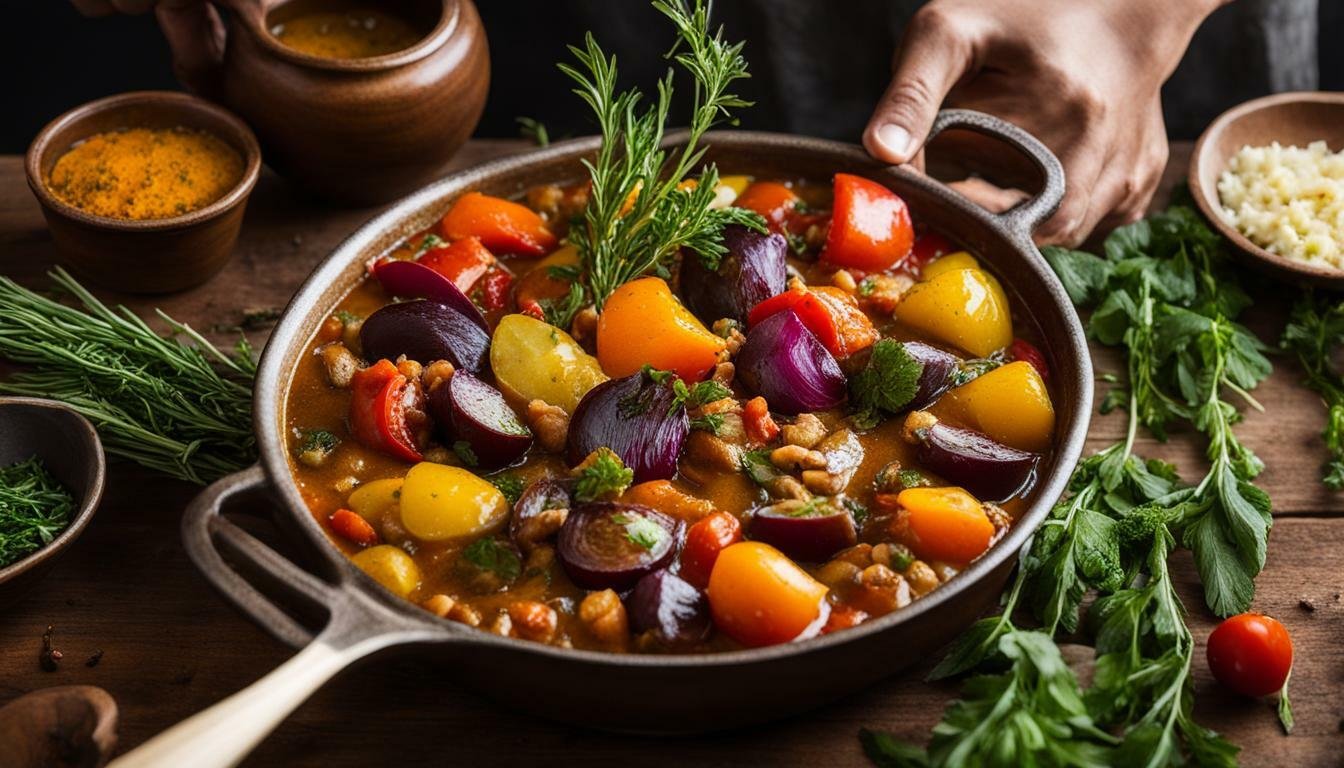Take Me to the Recipes
Across continents and cultures, Jewish cuisine weaves a tapestry of rich flavors and heartwarming traditions. From ancient recipes steeped in history to vibrant dishes reflecting diverse influences, Jewish food is more than just sustenance; it’s a story told on a plate.
Join us on an appetizing adventure as we explore the culinary landscape of the Jewish nation. This journey isn’t just about delicious recipes (although we’ve got 22 authentic ones waiting for you!); it’s about understanding the cultural influences, historical significance, and unique flavors that define Jewish cuisine.
Prepare to tantalize your taste buds with
- Hearty stews and succulent roasts: Warming dishes like chicken soup with matzo balls and slow-cooked brisket embody Jewish comfort food, passed down through generations.
- Spice-infused delights: Moroccan tagines, Ethiopian doro wat, and Yemeni Kubaneh showcase the diverse influences that have shaped Jewish cooking, offering a global flavor adventure.
- Festive staples: Explore iconic dishes like latkes (potato pancakes) for Hanukkah, hamantaschen for Purim, and challah bread for Shabbat, experiencing the culinary traditions woven into Jewish holidays.
- Sweet temptations: Indulge in delectable pastries like baklava and rugelach, or lighter options like apple strudel and cheesecake, discovering the sweet side of Jewish cuisine.
More than just delicious
As you delve into these recipes, remember that each bite carries a story. You’ll savor the heritage of families across the globe, understand the cultural significance of food in Jewish traditions, and appreciate the ingenuity and resourcefulness that shaped this unique cuisine.
Ready to embark on your culinary journey? Dive into our collection of 22 authentic Jewish recipes and unlock a world of delicious flavors, rich history, and cultural understanding.
Take Me to the Recipes
Israeli Cuisine – Key Takeaways
- Israeli cuisine is a fusion of Middle Eastern and Mediterranean flavors, rich in spices, herbs, and fresh ingredients.
- Traditional Israeli dishes offer a glimpse into the country’s cultural heritage and are beloved worldwide for their unique tastes and textures.
- Israeli cuisine is constantly evolving, with modern chefs experimenting with fusion flavors and innovative cooking techniques.
- Essential Israeli spices and ingredients, like za’atar, sumac, and tahini, add depth and complexity to dishes.
- Exploring Israeli cuisine in your own kitchen is a delightful way to savor the vibrant Mediterranean flavors and create unforgettable meals.
Where is Israel?

Israel is located in the Middle East, along the eastern coastline of the Mediterranean Sea, bordered by Lebanon, Syria, Jordan and Egypt. It lies at the junction of three continents: Europe, Asia and Africa. Long and narrow in shape, the country is about 290 miles (470 km.) in length and 85 miles (135 km.)

Index to the Contents
- Take Me to the Recipes
- More Articles
- Interesting Facts About Israel
- Israel’s History and the Affect It Has Had on the Cuisine
- What impact has the Climate and Geography had on Israeli Cuisine?
- The Melting Pot of Israeli Cuisine
- Israeli cuisine recipes
- Traditional Israeli Cuisine Recipes – Dishes
- Modern Israeli Cuisine Recipes – Culinary Innovations
- Essential Israeli Spices and Ingredients
- Israeli National Food
- How Healthy is Israeli Food?
- What does a Kosher Diet Mean?
- Here Are Some Israeli Cuisine Recipes you can try at Home
- Conclusion
- FAQ’s
You may also be interested in the following Articles
- North and South American Cuisine – A Culinary Expedition
- Europe Cuisine: Savor the Continent’s Best Culinary Secrets!
- African Cuisine: Discover the Bold Flavors & Global Charm!
- Asian Cuisine Unlock its Secrets – Taste, Health & Global Influence!
Savor iconic Israeli Recipes – Click on each tantalizing Image to open up the Recipe!
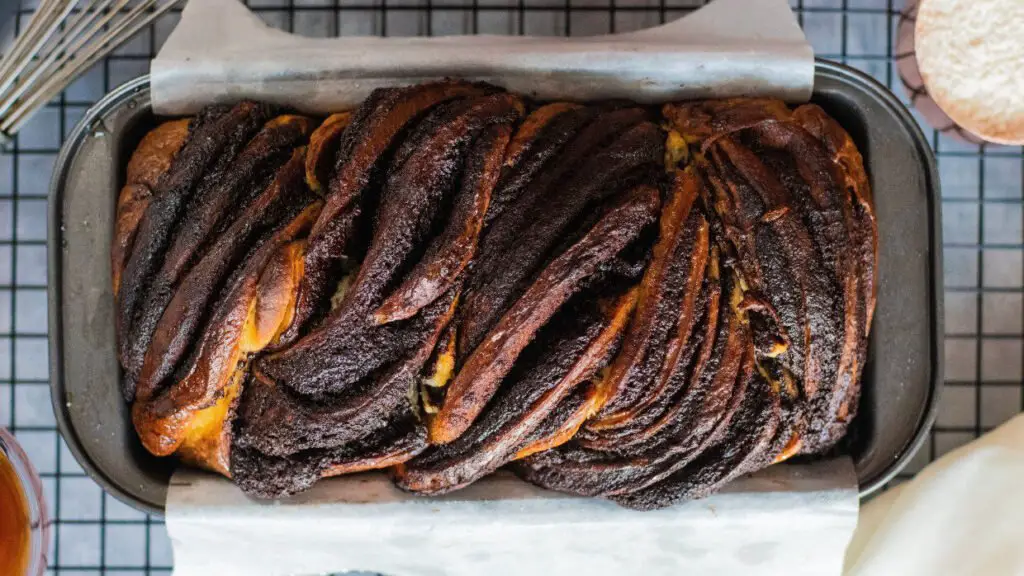
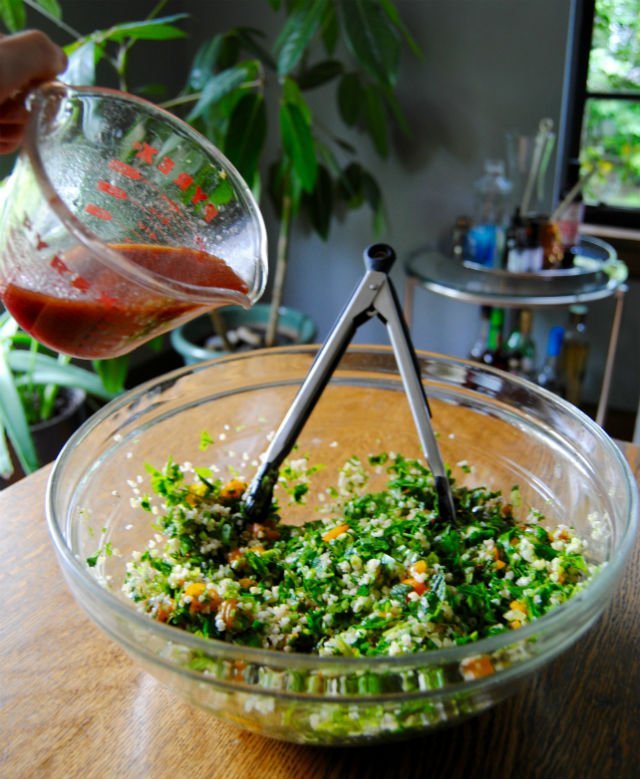
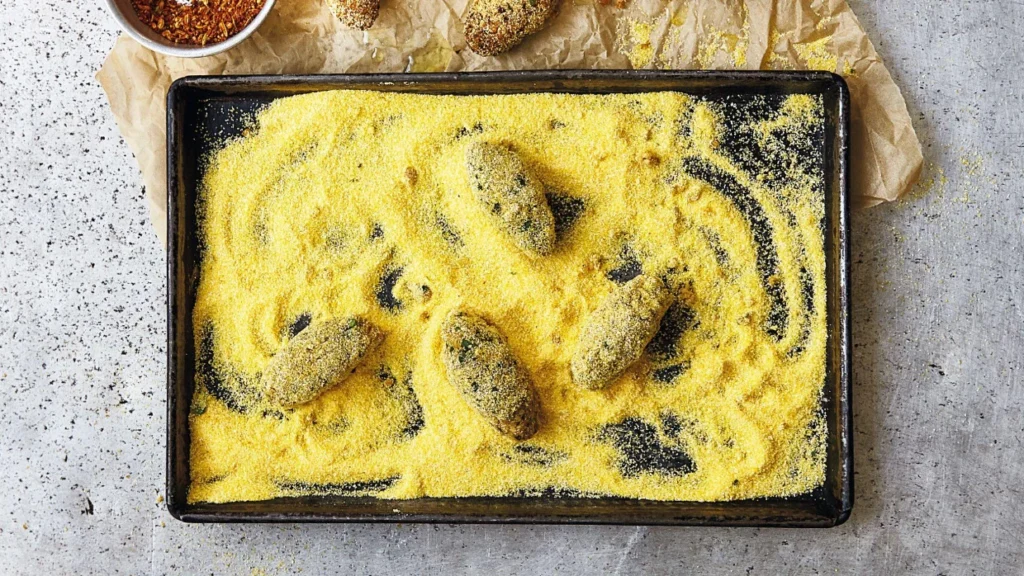
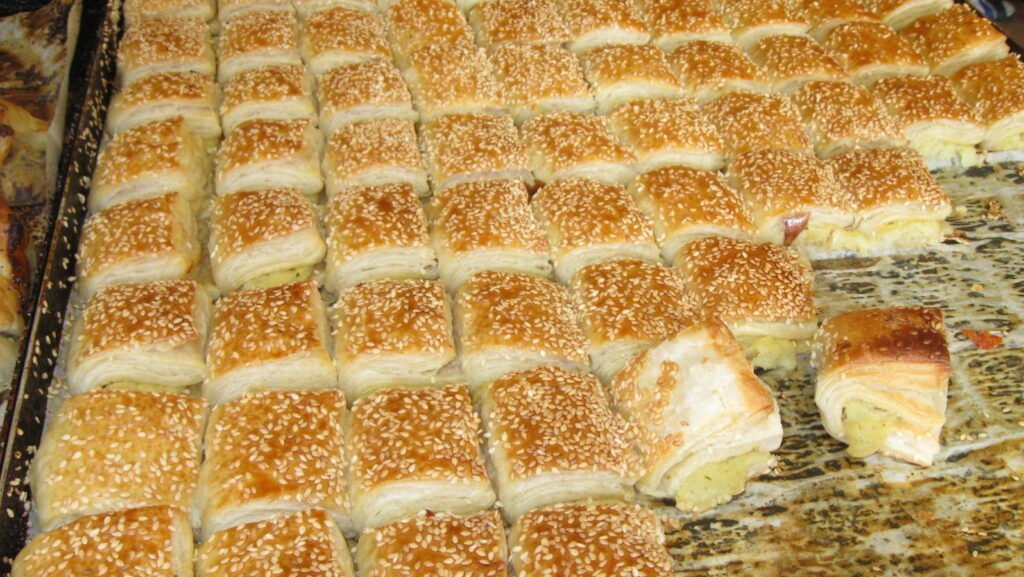
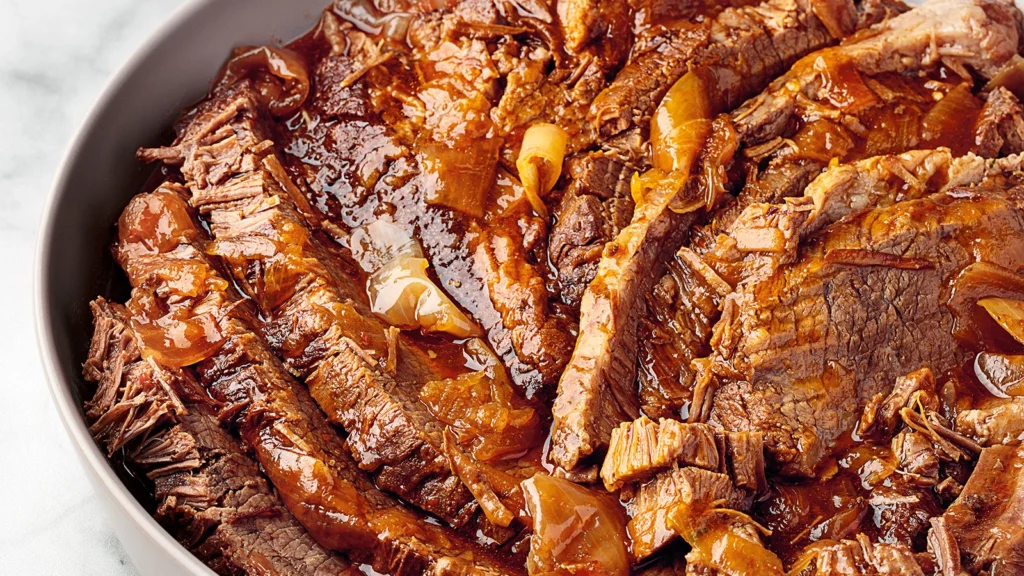
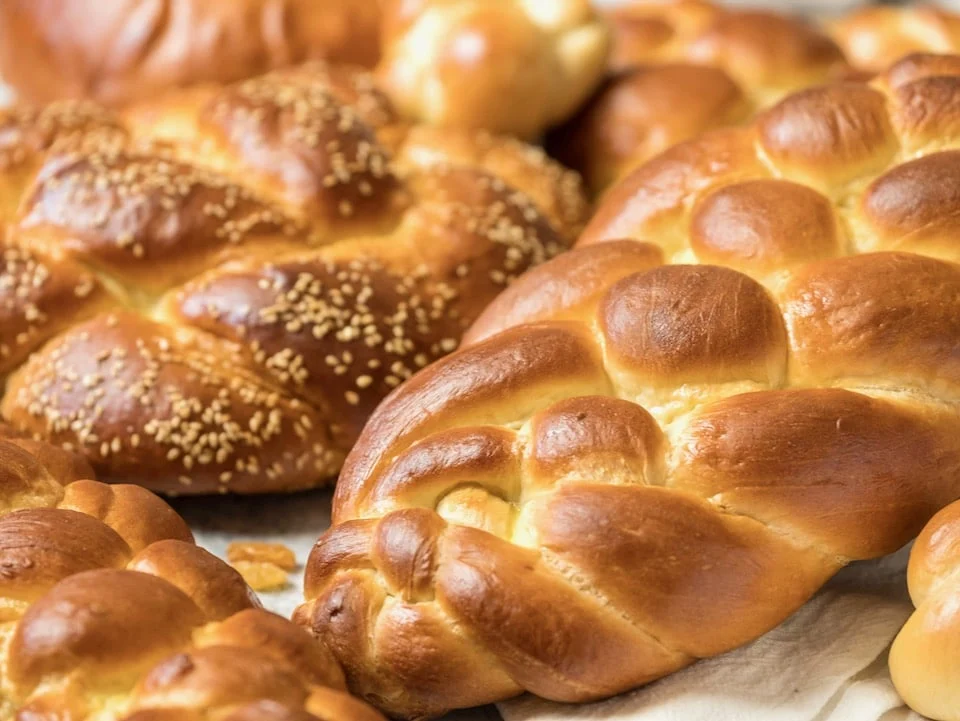

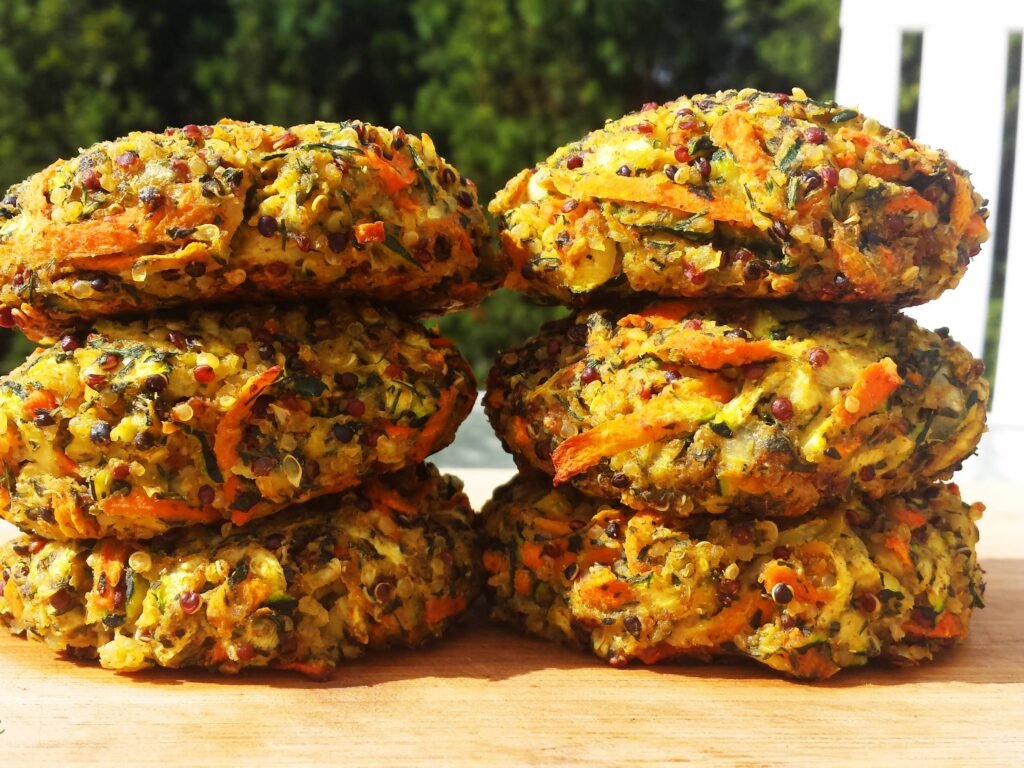
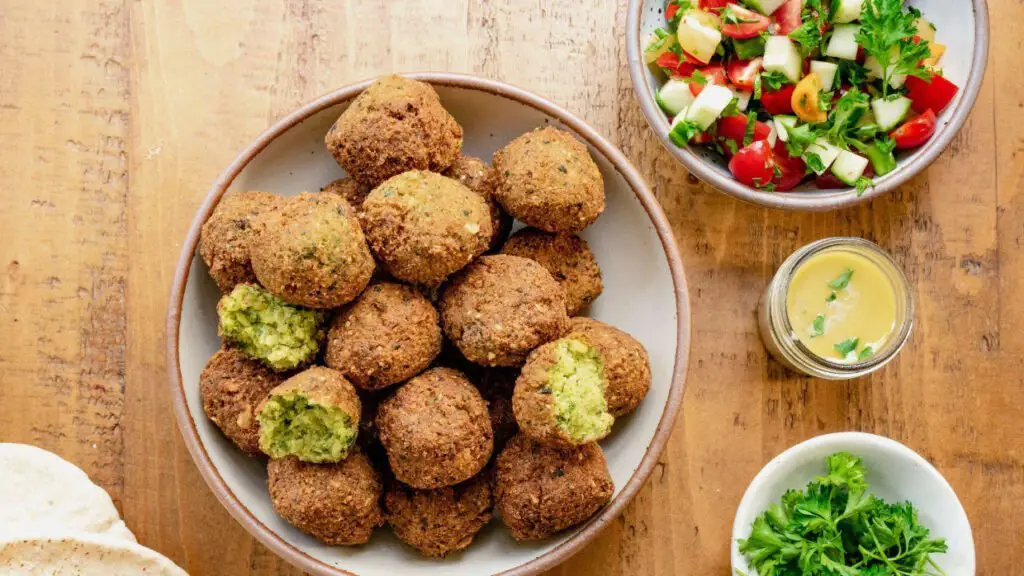



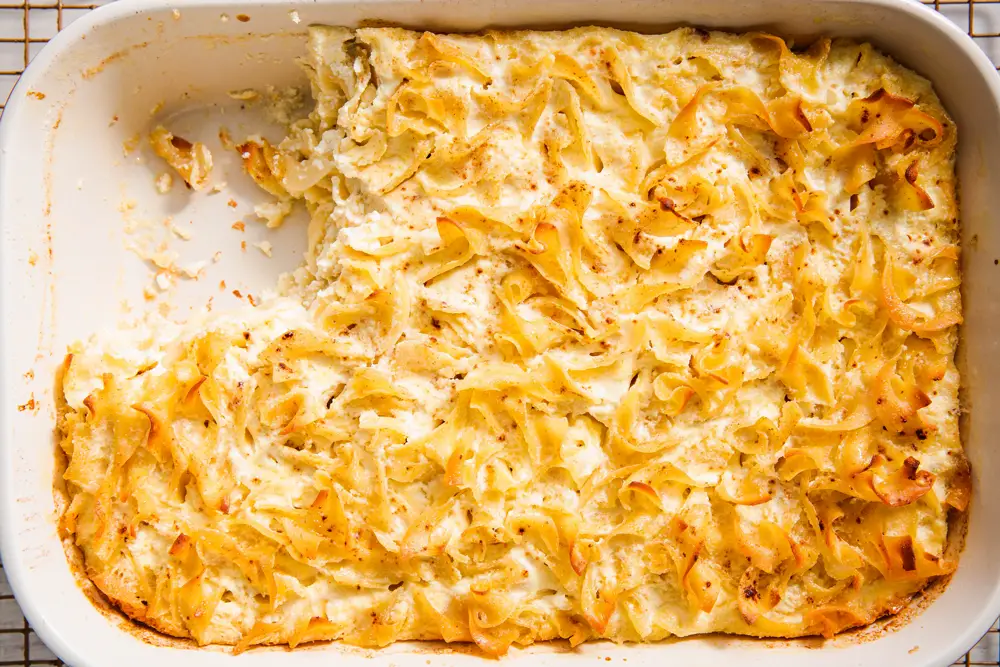
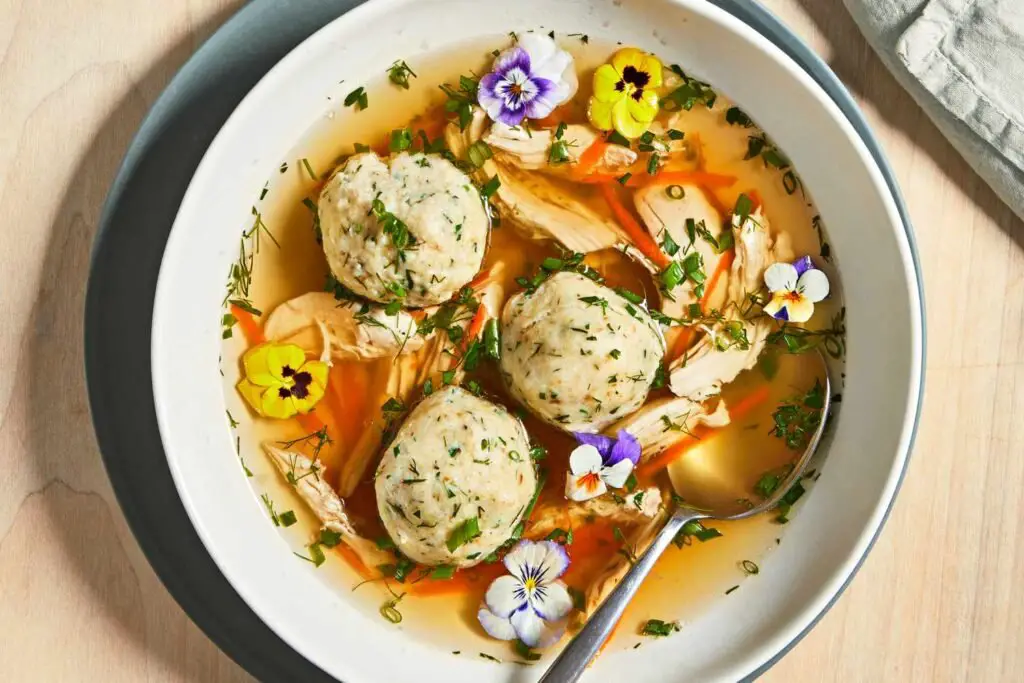
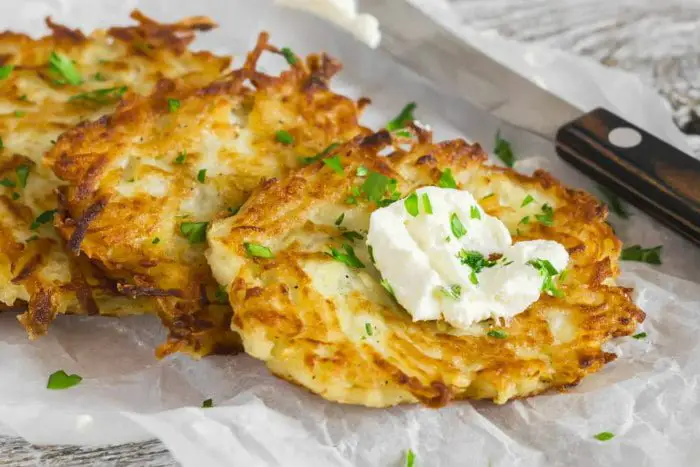



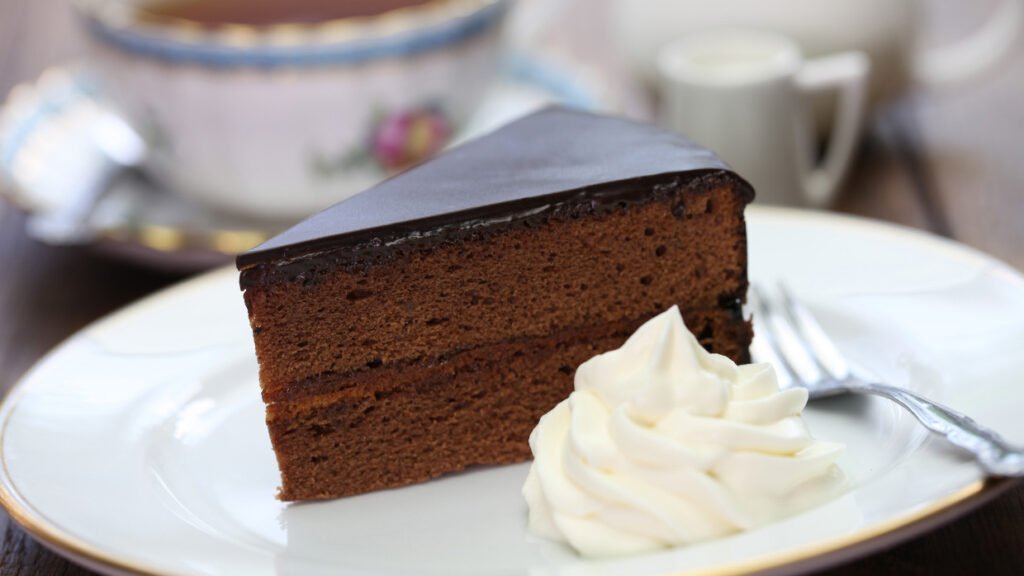


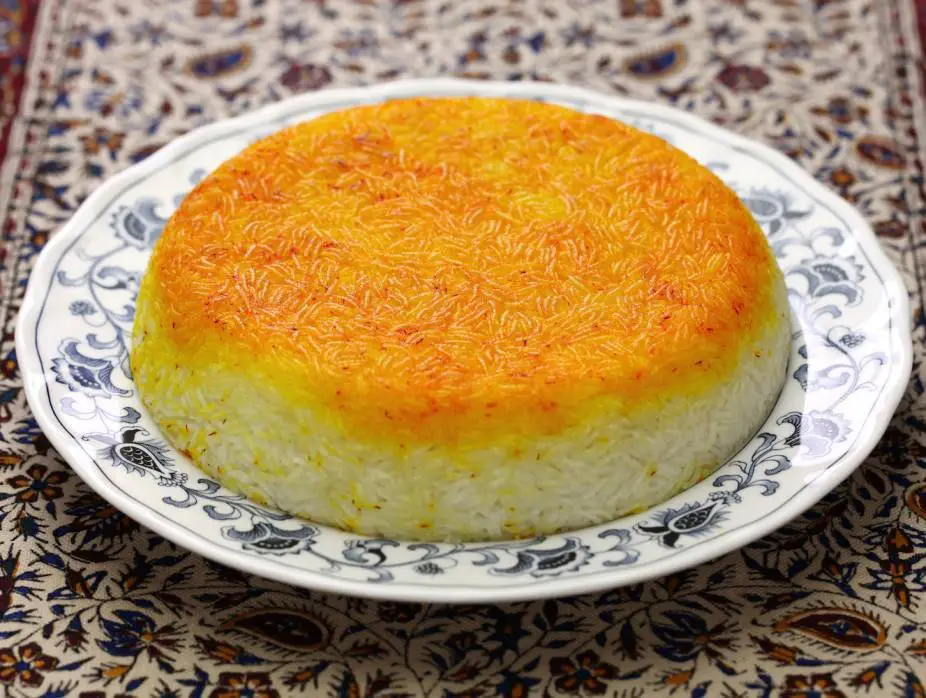
Interesting Facts About Israel
Diverse Landscape of Innovation

- Fact: Israel is often referred to as the “Startup Nation” due to its high number of tech startups per capita.
- Explanation: Despite its small size, Israel has a robust technological ecosystem, fostering innovation in areas like cybersecurity, agriculture, and medical research.
Mandatory Military Service

- Fact: Military service is compulsory for both men and women in Israel.
- Explanation: Because the country has to maintain a constant war footing, citizens serve in the Israel Defense Forces (IDF). It contributes to a strong sense of national identity and collective responsibility.
The Dead Sea’s Floating Experience
- Fact: The Dead Sea, bordering Israel, is so salty that people effortlessly float on its surface.
- Explanation: The high salt concentration makes it nearly impossible to sink, offering a unique and buoyant experience for swimmers.
Kibbutz Living Tradition
- Fact: Israel has a history of communal living in kibbutzim, where property and resources are shared.
- Explanation: Originally established as agricultural communities, modern kibbutzim reflect a blend of collective principles and individual pursuits.
City of Contrasts
- Fact: Jerusalem is home to holy sites for Judaism, Christianity, and Islam.
- Explanation: The Old City of Jerusalem hosts landmarks like the Western Wall, Church of the Holy Sepulchre, and the Dome of the Rock, creating a unique blend of religious diversity.
Innovation in Desert Agriculture

- Fact: Israel is a leader in desert agriculture, using advanced techniques like drip irrigation.
- Explanation: The Negev Desert has been transformed into fertile land, showcasing Israel’s expertise in maximizing agricultural productivity in arid regions.
Technological Wallflowers
- Fact: Israel developed a technology to protect its borders using smart flowers that bloom when sensing danger.
- Explanation: The security system, named “GreenWall,” combines technology and nature to detect and deter potential threats along the border.
Tel Aviv’s Vegan Vibe
- Fact: Tel Aviv is considered one of the most vegan-friendly cities globally.
- Explanation: The city boasts a vibrant vegan scene, with numerous plant-based restaurants and a cultural shift towards sustainable and cruelty-free living.
Famous Desert Blooms

- Fact: Every few years, the Negev Desert experiences a phenomenon called “desert blooms.”
- Explanation: After heavy rainfall, the seemingly barren desert transforms into a colorful display of wildflowers, showcasing the resilience of nature.
Bauhaus Architecture in Tel Aviv
- Fact: Tel Aviv has one of the largest concentrations of Bauhaus-style buildings globally.
- Explanation: Recognized as a UNESCO World Heritage site, the “White City” features over 4,000 buildings designed in the modernist Bauhaus architectural style.
Israel’s History and the Affect It Has Had on the Cuisine
Jewish history is one of the most documented periods in human development. Starting with Adam and Eve in the bible it spans through thousands of years when the nation of Israel was both conqueror and conquered.
It is impossible to discuss each period in the space of this article, instead I look at broad time frames categorized by the major impacts on the nation’s cuisine.
Jewish culinary history spans centuries and reflects a rich tapestry of cultural influences, religious practices, and regional adaptations. Here’s an overview of each period of Jewish culinary history, along with its timescales and the impact it has had on the cuisine:
Ancient Jewish Culinary Traditions (Pre-6th Century CE)

- Timescale: BC
- Impact:
- Rooted in biblical practices and dietary laws outlined in the Torah.
- Emphasized kosher dietary guidelines, separating meat and dairy.
- Featured ingredients like lamb, honey, fruits, and unleavened bread.
Diaspora and Hellenistic Influence (6th Century BC – 1st Century AD)

- Timescale: 6th Century BCE – 1st Century CE
- Impact:
- Jewish communities scattered, absorbing local culinary influences.
- Introduction of Hellenistic flavors, including olive oil, wine, and diverse spices.
- Fusion of Jewish dietary laws with Mediterranean ingredients.
Roman and Byzantine Period (1st – 7th Century AD)

- Timescale: 1st – 7th Century CE
- Impact:
- Incorporation of Roman culinary techniques and ingredients.
- Development of Jewish preserves and pickling methods.
- Increased use of fish, vegetables, and legumes in response to fasting traditions.
Islamic Golden Age (8th – 13th Century):
- Timescale: 8th – 13th Century
- Impact:
- Flourishing of Jewish culinary arts in Islamic lands.
- Introduction of exotic spices, rice, and complex flavors.
- Development of intricate meat and rice dishes, reflecting the opulence of the era.
Medieval and Renaissance Europe (13th – 17th Century)
- Timescale: 13th – 17th Century
- Impact:
- Influence of European ingredients, techniques, and traditions.
- Adaptation of Ashkenazi and Sephardic culinary distinctions.
- Development of dishes like gefilte fish (Ashkenazi) and tagines (Sephardic).
Ashkenazi and Sephardic Culinary Divergence (18th – 19th Century)

- Timescale: 18th – 19th Century
- Impact:
- Further crystallization of Ashkenazi and Sephardic culinary identities.
- Ashkenazi cuisine influenced by Eastern European staples like potatoes.
- Sephardic cuisine maintaining its Mediterranean and Middle Eastern roots.
Reestablishment of Israel – Jewish Culinary Fusion (1949 Century – Present)

Timescale: 20th Century – Present
Impact:
- Global migration leads to culinary fusion and experimentation.
- Emergence of Jewish-American cuisine influenced by diverse cultures.
- Revival of traditional dishes alongside innovative adaptations.
Jewish culinary history is a dynamic narrative, continually shaped by migrations, cultural exchanges, and religious practices. The cuisine reflects a fascinating journey of adaptation and preservation over millennia.
What impact has the Climate and Geography had on Israeli Cuisine?
The climate and geography of Israel have significantly influenced its vibrant and diverse cuisine. Let’s delve into this topic with some references:
Geographical Diversity

Israel’s compact size encompasses a remarkable range of climates and landscapes. Within this relatively small area, we find:
- Subtropical Climate: Near the Sea of Galilee, where mangoes, kiwis, and bananas thrive.
- Temperate Climate: In the mountains of Galilee and the Golan, where cherries and apples flourish.
This geographical diversity directly impacts the availability of ingredients and the types of crops that can be cultivated.
Historical and Religious Influences
Ancient Israeli cuisine revolved around seven primary foods: wheat, barley, grapes, figs, pomegranates, olives, and dates.
Mediterranean influence introduced additional ingredients such as tomatoes, eggplants, zucchini, and chickpeas to Israeli tables.
Freshness and Seasonality
Israeli cuisine places a strong emphasis on fresh, seasonal ingredients. The favorable climate allows for a wide variety of fruits, vegetables, and herbs to flourish.
From the Mediterranean coast to the bustling streets of Tel Aviv, Israeli chefs celebrate bold flavors and cultural influences in their dishes.
The unique blend of climate, geography, history, and cultural exchange has shaped Israeli cuisine into a global phenomenon, enticing food lovers worldwide. 🌿🍅🍋🍆🍇🍯
References
- My Jewish Learning: The Evolution of Israeli Cuisine
- Healthy Family Connecticut: Diving into Israeli Cuisine
- The Jerusalem Post: Israeli Cuisine and Middle Eastern Influences
The Melting Pot of Israeli Cuisine

Israel is a country with a rich history and diverse cultural influences, and its cuisine reflects this melting pot of culinary traditions. Middle Eastern cuisine has had a significant impact on Israeli food, especially in terms of spices and cooking techniques. However, Israeli cuisine also draws inspiration from North Africa, Europe, and beyond.
Historically, Jewish communities from around the world have brought their own unique flavors and ingredients to Israeli cuisine. For example, the Sephardic Jews, who originated from the Iberian Peninsula, introduced foods such as eggplant, chickpeas, and saffron to Israeli cooking. Meanwhile, the Ashkenazi Jews, who came from Central and Eastern Europe, brought dishes like knish, gefilte fish, and kugel.
Today, Israeli cuisine is characterized by a fusion of cultural influences and a focus on fresh, seasonal ingredients. Traditional Middle Eastern dishes like hummus, shakshuka, and falafel remain popular staples, but Israeli chefs are also pushing culinary boundaries and experimenting with new flavors and techniques.
The Influence of Middle Eastern Cuisine
Perhaps the biggest influence on Israeli cuisine is Middle Eastern cuisine. The flavors and spices of Middle Eastern cooking are evident in many Israeli dishes, including shawarma, tabbouleh, and kebabs. Middle Eastern cuisine is known for its use of herbs like parsley, cilantro, and mint, as well as spices like cumin, coriander, and turmeric. These ingredients are often used in Israeli cooking to add warmth and depth to dishes.
Another hallmark of Middle Eastern cuisine is the use of flatbreads like pita and laffa. These breads are often used as a vessel for dips like hummus, baba ghanoush, and labneh, or as a base for sandwiches like falafel and shawarma. In Israeli cuisine, flatbreads are a staple and can be found in nearly every meal.
Overall, Israeli cuisine is a vibrant and flavorful reflection of the country’s unique cultural heritage. From traditional dishes to modern innovations, Israeli food continues to excite and delight food lovers around the world.
Israeli Cuisine Recipes

Israeli cuisine recipes are known for their rich and diverse flavors.
From traditional dishes like falafel and hummus to modern twists on classics, Israeli cuisine recipes cater to a wide range of tastes. With a focus on fresh ingredients and bold spices, these recipes showcase the vibrant culinary heritage of the region.
Whether it’s enjoying a hearty plate of shakshuka for breakfast or savoring a comforting bowl of sabich for lunch, Israeli cuisine offers a delightful culinary journey for food enthusiasts around the world.
Traditional Israeli Cuisine Recipes – Dishes
Get ready to tantalize your taste buds with these classic Israeli dishes that are sure to become favorites in your home.
| Dish | Description |
|---|---|
| Falafel | A crispy and savory chickpea patty, often served in a pita with fresh veggies and tahini sauce. |
| Hummus | A creamy and flavorful dip made from mashed chickpeas, tahini, lemon juice, and garlic. |
| Shakshuka | A hearty and comforting dish of eggs poached in a flavorful tomato sauce with onions, peppers, and spices. |
| Sabich | A delicious pita sandwich filled with crispy fried eggplant, hard-boiled eggs, Israeli salad, and tahini sauce. |
These dishes are just the tip of the iceberg when it comes to Israeli culinary delights. With a focus on fresh and seasonal ingredients, Israeli Cuisine Recipes are often healthy and balanced, making them perfect for everyday meals. So why not add some Israeli flair to your next dinner party or weeknight dinner with these delicious dishes?
Modern Israeli Cuisine Recipes – Culinary Innovations

Israeli cuisine is not just about preserving traditional recipes. It is also known for its innovation and creativity. The modern culinary scene in Israel is full of talented chefs who are pushing boundaries and reimagining traditional dishes with a contemporary twist.
One notable example is chef Eyal Shani, who is known for his inventive approach to cooking. His restaurant, Miznon, has gained a cult following for its take on classic Israeli dishes such as roasted cauliflower and shawarma. Shani’s unconventional cooking techniques, like charring vegetables to create a smoky flavor, have inspired chefs around the world.
Another rising star in the Israeli culinary scene is chef Assaf Granit, who has made a name for himself with his creative fusion dishes. At his restaurant, The Palomar, Granit combines traditional Middle Eastern ingredients with European flavors to create a unique and memorable dining experience. His dishes, like the polenta with asparagus and truffle oil, have become instant classics.
Whether it’s adding unexpected ingredients to classic dishes or experimenting with new cooking techniques, Israeli chefs are constantly pushing the boundaries of what is possible in the kitchen. If you want to experience the excitement and creativity of modern Israeli cooking, be sure to visit one of the many innovative restaurants in Tel Aviv or Jerusalem.
Essential Israeli Spices and Ingredients
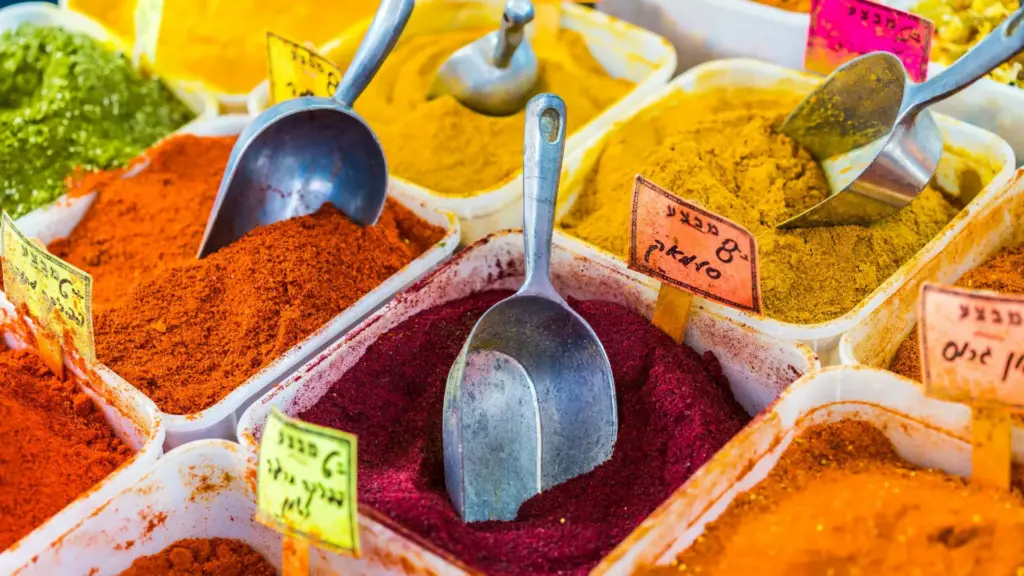
If you want to create authentic Israeli flavors in your cooking, you need the right spices and ingredients. Israeli cuisine is known for its use of vibrant and bold flavors, and these essential spices and ingredients are what make the dishes so delicious.
Israeli Cuisine Recipes – Za’atar
This fragrant spice blend is a staple in Israeli cuisine, made from a mixture of thyme, oregano, sesame seeds, and sumac. It adds an earthy aroma to dishes and pairs well with meats, vegetables, and dips like hummus.
Israeli Cuisine Recipes – Cumin
Another important spice in Middle Eastern cooking, cumin has a warm and nutty flavor that is perfect for seasoning stews and meats. It’s also a key ingredient in falafel, a popular Israeli dish.
Israeli Cuisine Recipes – Sumac
This tangy spice is made from dried and ground sumac berries and adds a delicious citrusy kick to dishes. It’s often used to season meats, vegetables, and salads.
Israeli Cuisine Recipes – Tahini
Made from ground sesame seeds, tahini is a creamy and nutty paste that is a key ingredient in many Israeli dips and sauces, like hummus and baba ganoush. You can also use it as a dressing for salads or drizzle it on roasted vegetables.
Israeli Cuisine Recipes – Pomegranate molasses
This tangy and sweet syrup is made from reduced pomegranate juice and adds a unique flavor to dishes. It’s often used in marinades, dressings, and sauces.
Israeli Cuisine Recipes – Cilantro
A herb with a bright and citrusy flavor, cilantro is often used in Israeli cooking to add freshness to dishes. It pairs well with spicy flavors and is a great addition to salads, soups, and stews.
These are just a few of the essential Israeli spices and ingredients that you should have in your pantry if you want to recreate the delicious flavors of Israeli cuisine. Experiment with different combinations and see what works best for your taste buds.
Israeli National Food

While there’s no officially declared “national food” of Israel, two dishes frequently come up in the conversation: falafel and hummus.
Israeli National Food Falafel
Deep-fried balls made from ground chickpeas, spices, and herbs, wrapped in pita bread with toppings like tahini, vegetables, and pickles. It’s widely considered the most iconic street food in Israel and enjoyed by locals and tourists alike.
Israeli National Food Hummus
A creamy dip made from mashed chickpeas, tahini, olive oil, and spices. It’s incredibly versatile, served with pita bread, vegetables, falafel, or even as part of larger meals. While popular worldwide, its deep roots in Middle Eastern cuisine and ubiquity in Israel make it a strong contender for national dish status.
Ultimately, the choice depends on who you ask and what criteria you use. Falafel holds the title of “national dish” in many informal polls and guides, but hummus might be argued to be more emblematic of Israeli cuisine thanks to its historical significance and diverse usage.
How Healthy is Israeli Food?

Israeli cuisine is renowned for its healthful qualities, and there are several reasons why it’s considered a healthy way of eating:
Mediterranean Diet Foundation
Israel’s dietary foundation aligns with the Mediterranean diet, which is common to all countries bordering the Mediterranean Sea.
This diet emphasizes:
- Whole Grains: Including foods like whole wheat bread and couscous.
- Plant-Based Foods: Such as fruits, vegetables, legumes, and nuts.
- Healthy Fats: Especially extra-virgin olive oil.
- Moderate Fish and Poultry Intake: While limiting dairy, red meats, and processed foods.
The Mediterranean diet is not only healthful but also sustainable when sourced locally1.
Fresh and Vibrant Salads
Chopped salad is a staple in Israeli meals. It typically consists of locally grown cucumbers and tomatoes, dressed with herbs, sea salt, extra-virgin olive oil, and lemon juice.
Israelis consume a substantial number of fruits and vegetables, promoting overall health.
Low Saturated Fat Intake
Israelis consume less saturated fat compared to many Western countries.
Butter is minimal, but soybean, corn, and safflower oils are commonly used2.
Emphasis on Fruits and Vegetables
Israeli cuisine celebrates fresh produce. As of 2018, each resident has access to an average of 152 kilograms of fruit and 154 kilograms of vegetables annually.
Heart-Healthy Fats
Most of the fat in Israeli diets comes from sources like olives, healthy oils, nuts, and avocados.
Cultural Aspects of Dining
Israelis value communal mealtimes, emphasizing social and cultural connections during food consumption.
Israeli food promotes health through its focus on plant-based ingredients, heart-healthy fats, and fresh produce. So, whether it’s a vibrant salad or a smoothie packed with vitamins, Israeli cuisine offers a delicious and nutritious experience! 🥗🍋🥑
References
- ISRAEL21c: 13 Reasons You Should Eat Like an Israeli
- Jamie Geller: Health Benefits of the Israeli Diet
- timesofisrael.com
- myadventuresacrosstheworld.com
What does a Kosher Diet Mean?

Have you ever wondered why some people follow a particular set of dietary guidelines called “kosher”? Contrary to popular belief, it’s not just about avoiding bacon! The kosher diet, observed by people of the Jewish faith, is a complex and fascinating system woven with religious significance, historical context, and cultural traditions.
The Foundation: The Torah (Bible)
The core principles of the kosher diet stem from the Torah, specifically the books of Leviticus and Deuteronomy. These texts outline permitted and forbidden foods, laying the foundation for a way of life centered around mindful consumption.
While the Torah provides the initial framework, rabbinic interpretation and centuries of tradition have further shaped and evolved the kosher guidelines.
What’s on the Menu (and What’s Not)
- Permitted Foods: Kosher diets focus on pure and naturally occurring foods, like fruits, vegetables, fish with fins and scales, and animals with cloven hooves that chew their cud (think cows, sheep, and goats).
- Forbidden Foods: Certain animals are deemed non-kosher, including pigs, shellfish, and birds of prey. Additionally, mixing meat and dairy is prohibited, requiring separate sets of dishes and utensils.
Beyond the Plate: A Deeper Meaning
Following a kosher diet goes beyond physical nourishment; it’s a way of connecting to God and tradition. It embodies concepts like respect for life, mindful consumption, and gratitude. Each bite serves as a reminder of the divine and one’s role in the world.
The “Why” Behind the “What”
Several reasons lie behind the observance of kosher:
- Obedience to God: Following God’s commandments, as outlined in the Torah, is a core tenet of faith for many Jews.
- Holistic Wellbeing: The kosher diet is seen as contributing to physical and spiritual well-being, promoting mindful eating and ethical sourcing.
- Community and Identity: Sharing kosher meals strengthens community bonds and reinforces Jewish identity across generations.
References
Here Are Some Israeli Cuisine Recipes you can try at Home
Craving a taste of adventure but stuck at home? Look no further than the vibrant flavors of Israeli cuisine! This chapter uncorks a treasure trove of authentic recipes, each one an invitation to savor the sun-kissed magic of Israel right in your own kitchen.
Forget complicated techniques and hard-to-find ingredients. We’ve curated a collection of easy-to-follow recipes using readily available ingredients. So, whether you’re a seasoned cook or a kitchen newbie, get ready to whip up delectable dishes like falafel bursting with fresh herbs, fluffy pita bread straight from the oven, and flavorful shakshuka simmering with eggs and spices.
But beyond the deliciousness, each recipe offers a taste of Israeli culture and history. Imagine yourself strolling through bustling markets, the aroma of spices filling the air. Imagine sharing laughter and stories over a communal table laden with vibrant dishes. With every bite, you’ll embark on a culinary journey to the heart of Israel.
So, roll up your sleeves, prepare your taste buds, and let’s get cooking! Discover the magic of Israeli cuisine and unlock a world of flavor in your own home.
Jewish Food – Greek Style Falafel Fritters

Unraveling Culinary Tales: Greek-Style Falafel Fritters
Embark on a flavor journey with these Greek-style falafel fritters, a delightful fusion of Mediterranean influences. Originating from the Middle East, falafel has been embraced by various regions, each adding its unique twist.
Our recipe takes inspiration from the vibrant flavors of Greece, incorporating fresh herbs and a zesty touch.
Jewish Food – Greek Style Falafel Fritters Ingredients
Falafel:
- 2 cups canned chickpeas, drained and rinsed
- 1 small onion, roughly chopped
- 3 cloves garlic
- 1 cup fresh parsley, chopped
- 1 cup fresh cilantro, chopped
- 1 teaspoon ground cumin
- 1 teaspoon ground coriander
- 1 teaspoon baking powder
- Salt and pepper to taste
- 1/4 cup all-purpose flour (optional, for binding)
- Olive oil for frying
Tzatziki Sauce:
- 1 cup Greek yogurt
- 1/2 cucumber, grated and drained
- 2 tablespoons fresh dill, chopped
- 1 clove garlic, minced
- 1 tablespoon lemon juice
- Salt and pepper to taste
Jewish Food – Greek Style Falafel Fritters Recipe
1. Making the Falafel Mixture:
a. In a food processor, combine chickpeas, onion, garlic, parsley, cilantro, cumin, coriander, baking powder, salt, and pepper. b. Pulse until the mixture reaches a coarse texture. c. If needed, add flour to bind the mixture. Refrigerate for 30 minutes.
2. Forming Falafel Patties:
a. Shape the falafel mixture into small patties, about 2 inches in diameter. b. Heat olive oil in a pan over medium heat. c. Fry falafel patties until golden brown on both sides. Place on paper towels to absorb excess oil.
3. Preparing Tzatziki Sauce:
a. In a bowl, combine Greek yogurt, grated cucumber, dill, minced garlic, lemon juice, salt, and pepper. b. Mix well and refrigerate until serving.
4. Serving the Greek-Style Falafel Fritters:
a. Serve falafel fritters hot, accompanied by the refreshing tzatziki sauce. b. Optionally, serve with pita bread, sliced tomatoes, and cucumbers.
Serving Information:
- Serves: 4 people
- Estimated Cooking Time: 45 minutes
- Estimated Calories (per serving):
- Falafel (3 pieces): 200 calories
- Tzatziki Sauce (2 tablespoons): 50 calories
Experience the crispiness of Greek-style falafel fritters paired with the coolness of tzatziki sauce. This recipe captures the essence of Mediterranean flavors and makes for a delightful, shared meal. Enjoy this savory delight that transcends borders and brings a piece of Greek warmth to your table. Opa!
Jewish Food – BBQ Falafel Croquettes

Unwrapping Flavorful Tales: BBQ Falafel Croquettes
Delve into the delectable world of BBQ Falafel Croquettes, a modern twist on the beloved Middle Eastern classic. Originating from the Levant, falafel has charmed taste buds for centuries.
This reinvention introduces a smoky BBQ flavor, blending tradition with a zesty contemporary touch.
Jewish Food – BBQ Falafel Croquettes Ingredients
Falafel Croquettes:
- 2 cups canned chickpeas, drained and rinsed
- 1 small onion, finely chopped
- 3 cloves garlic, minced
- 1 cup fresh parsley, chopped
- 1 teaspoon ground cumin
- 1 teaspoon smoked paprika
- 1/2 teaspoon cayenne pepper
- 1 teaspoon baking powder
- Salt and pepper to taste
- 1/4 cup all-purpose flour
- BBQ sauce for coating
- Vegetable oil for frying
Tahini Dipping Sauce:
- 1/2 cup tahini
- 2 tablespoons lemon juice
- 1 clove garlic, minced
- Salt and pepper to taste
- Water (to adjust consistency)
Jewish Food – BBQ Falafel Croquettes Recipe
1. Crafting the Falafel Mixture:
a. In a food processor, blend chickpeas, onion, garlic, parsley, cumin, smoked paprika, cayenne pepper, baking powder, salt, and pepper. b. Add flour to bind the mixture. Refrigerate for 30 minutes.
2. Forming BBQ Falafel Croquettes:
a. Shape falafel mixture into small croquettes or patties. b. Heat vegetable oil in a pan over medium heat. c. Fry croquettes until golden brown. Remove and let excess oil drain on paper towels.
3. Coating with BBQ Sauce:
a. Brush each falafel croquette generously with BBQ sauce. b. Place the sauced croquettes on a baking sheet.
4. Baking for Final Crispiness:
a. Preheat the oven to 350°F (175°C). b. Bake BBQ-coated croquettes for 15-20 minutes, turning halfway for even crispiness.
5. Crafting Tahini Dipping Sauce:
a. In a bowl, whisk together tahini, lemon juice, minced garlic, salt, and pepper. b. Adjust consistency by adding water as needed.
Serving Information:
- Serves: 4 people
- Estimated Cooking Time: 1 hour
- Estimated Calories (per serving):
- BBQ Falafel Croquettes (4 pieces): 250 calories
- Tahini Dipping Sauce (2 tablespoons): 100 calories
Celebrate the fusion of smoky BBQ goodness with the timeless charm of falafel. These BBQ Falafel Croquettes, paired with a creamy tahini dipping sauce, make for a satisfying and flavor-packed experience. Gather around and relish the dynamic blend of tradition and innovation on your plate!
Jewish Food – Gram Flour and Harissa Patties

Unveiling Culinary Heritage: Gram Flour and Harissa Patties
Embark on a culinary adventure with Gram Flour and Harissa Patties, a fusion inspired by the vibrant flavors of the Middle East.
Originating from Jewish communities with diverse culinary influences, this dish marries the nutty richness of gram flour with the fiery kick of harissa, creating a tantalizingly unique experience.
Jewish Food – Gram Flour and Harissa Patties Ingredients:
Patties:
- 2 cups gram flour (besan)
- 1 large onion, finely chopped
- 2 green chilies, minced
- 1/2 cup fresh cilantro, chopped
- 1/2 cup harissa paste
- 1 teaspoon ground cumin
- 1 teaspoon ground coriander
- 1/2 teaspoon turmeric powder
- Salt to taste
- Water for batter consistency
- Vegetable oil for frying
Yogurt Dipping Sauce:
- 1 cup Greek yogurt
- 1 tablespoon lemon juice
- 1 teaspoon honey
- Salt and pepper to taste
Jewish Food – Gram Flour and Harissa Patties Recipe
1. Crafting Gram Flour Batter:
a. In a mixing bowl, combine gram flour, chopped onion, minced green chilies, cilantro, harissa paste, cumin, coriander, turmeric, and salt. b. Gradually add water, stirring until a thick batter forms.
2. Shaping and Frying Patties:
a. Heat vegetable oil in a pan over medium heat. b. Spoon dollops of the gram flour batter into the hot oil, shaping them into round patties. c. Fry until golden brown on both sides. Place on paper towels to absorb excess oil.
3. Preparing Yogurt Dipping Sauce:
a. In a separate bowl, whisk together Greek yogurt, lemon juice, honey, salt, and pepper. b. Adjust taste and consistency as needed.
4. Serving the Gram Flour and Harissa Patties:
a. Serve the patties hot, accompanied by the refreshing yogurt dipping sauce. b. Optionally, garnish with additional cilantro for freshness.
Serving Information:
- Serves: 4 people
- Estimated Cooking Time: 30 minutes
- Estimated Calories (per serving):
- Gram Flour and Harissa Patties (3 pieces): 200 calories
- Yogurt Dipping Sauce (2 tablespoons): 50 calories
Experience the bold harmony of gram flour and harissa, a dish that celebrates the diverse flavors woven into Jewish culinary traditions. These patties, paired with a cooling yogurt sauce, are perfect for sharing and savoring the rich tapestry of Middle Eastern-inspired tastes. Enjoy the delightful journey on your palate!
Jewish Food – Babka in a Bag

Journey Through Tradition: Babka in a Bag
Explore the delightful world of Jewish cuisine with a modern twist on the classic Babka. Rooted in Eastern European traditions, Babka has evolved over generations, and now we bring you a simplified version – Babka in a Bag.
Perfect for the cozy atmosphere of your home, this recipe preserves the essence of the rich, swirled bread while making it accessible for all home bakers.
Jewish Food – Babka in a Bag Ingredients
Babka Dough:
- 4 cups all-purpose flour
- 1/2 cup sugar
- 2 1/4 teaspoons active dry yeast
- 1 cup warm milk
- 1/2 cup unsalted butter, melted
- 2 large eggs
- 1 teaspoon vanilla extract
- 1/2 teaspoon salt
Filling:
- 1/2 cup unsalted butter, softened
- 1 cup brown sugar
- 2 tablespoons ground cinnamon
- 1/2 cup chocolate chips (optional)
Jewish Food – Babka in a Bag Recipe
1. Crafting the Babka Dough:
a. In a bowl, dissolve yeast in warm milk and let it sit for 5 minutes until frothy. b. In a large mixing bowl, combine flour, sugar, melted butter, eggs, vanilla extract, and salt. c. Pour in the yeast mixture and knead until a soft dough forms. Let it rise in a warm place for 1 hour.
2. Preparing the Filling:
a. Mix together softened butter, brown sugar, and ground cinnamon to create a spreadable mixture.
3. Assembling the Babka:
a. Roll out the risen dough into a rectangle. b. Spread the filling evenly over the dough’s surface. c. If desired, sprinkle chocolate chips for an extra layer of indulgence. d. Roll the dough tightly and slice it in half lengthwise.
4. Twisting and Baking:
a. Twist the two halves together, forming a braided pattern. b. Place the twisted dough into a greased baking pan. c. Bake at 350°F (175°C) for 30-35 minutes until golden brown.
Serving Information:
- Serves: 8 people
- Estimated Cooking Time: 2 hours (including rising time)
- Estimated Calories (per serving): 300 calories
Indulge in the aroma of freshly baked Babka in a Bag, a delightful treat that combines the warmth of tradition with the convenience of a home kitchen. Share this sweet creation with loved ones and savor the comforting taste of homemade Babka at its finest.
Jewish Food – Sachertorte (Chocolate Cake)

A Slice of Austrian Elegance: Sachertorte – Chocolate Cake
Dive into the decadence of Sachertorte, a legendary chocolate cake that traces its origins to the heart of Austria with an Israeli twist. This delectable dessert has earned its place as a symbol of Israeli culinary artistry, celebrated for its velvety chocolate layers and signature apricot glaze.
Bring a taste of Viennese sophistication to your kitchen with this Sachertorte recipe.
Jewish Food – Sachertorte Ingredients
Cake:
- 1 cup all-purpose flour
- 1/2 cup unsweetened cocoa powder
- 1 teaspoon baking powder
- 1/2 teaspoon salt
- 4 ounces dark chocolate, chopped
- 1/2 cup unsalted butter
- 1 cup granulated sugar
- 4 large eggs
- 1 teaspoon vanilla extract
Apricot Glaze:
- 1/2 cup apricot jam
- 2 tablespoons water
Chocolate Ganache:
- 4 ounces dark chocolate, chopped
- 1/2 cup heavy cream
- 2 tablespoons unsalted butter
Jewish Food – Sachertorte Recipe
Preparing the Cake Batter:
- Preheat the oven to 350°F (175°C) and grease a round cake pan.
- In a bowl, sift together flour, cocoa powder, baking powder, and salt.
- Melt the dark chocolate and butter together. Let it cool.
- In another bowl, beat sugar, eggs, and vanilla extract until fluffy.
- Gradually add the dry ingredients and melted chocolate mixture.
- Mix until smooth.
- Pour the batter into the prepared pan and bake for 25-30 minutes.
Making the Apricot Glaze:
- In a saucepan, heat apricot jam and water until it forms a smooth glaze.
- Strain to remove any chunks.
Crafting the Chocolate Ganache
- Heat cream until it simmers, then pour it over chopped dark chocolate.
- Add butter and stir until a glossy ganache forms.
Assembling the Sachertorte:
- Once the cake has cooled, brush the apricot glaze over the top and sides.
- Pour the chocolate ganache over the cake, allowing it to drip down the sides.
- Let it set before slicing and serving.
Serving Information:
- Serves: 10 people
- Estimated Cooking Time: 1 hour
- Estimated Calories (per serving): 350 calories
Indulge in the richness of Sachertorte, a dessert that encapsulates the elegance of Austrian baking. Share this chocolate delight with friends and family and savor each decadent bite that echoes the sweet history of Viennese patisseries.
Jewish Food – Simple Strawberry Rugelach

Nostalgic Delight: Simple Strawberry Rugelach
Embark on a sweet journey through Jewish culinary history with Simple Strawberry Rugelach, a treat that harks back to the kitchens of Eastern European Jews.
This delightful pastry, with its flaky layers and fruity filling, captures the essence of Jewish baking traditions. Originating from the region of Ashkenazi Jews, rugelach has become a beloved dessert in Jewish households and beyond.
Jewish Food – Simple Strawberry Rugelach Ingredients
Dough:
- 2 cups all-purpose flour
- 1/4 teaspoon salt
- 1 cup unsalted butter, cold and cubed
- 8 ounces cream cheese, cold and cubed
- 1/4 cup granulated sugar
- 1 teaspoon vanilla extract
Filling:
- 1/2 cup strawberry jam
- 1/2 cup finely chopped walnuts
- 2 tablespoons granulated sugar
- 1 teaspoon ground cinnamon
Jewish Food – Simple Strawberry Rugelach Recipe
Crafting the Dough:
- In a food processor, pulse flour and salt.
- Add cold butter, cream cheese, sugar, and vanilla extract. Pulse until a dough forms.
- Divide the dough into two discs,
- Wrap in plastic.
- Refrigerate for at least 1 hour.
Preparing the Filling:
- In a bowl, mix strawberry jam, chopped walnuts, sugar, and ground cinnamon.
Rolling and Filling
- Preheat the oven to 350°F (175°C) and line a baking sheet with parchment paper.
- Roll out one disc of dough on a floured surface into a circle.
- Spread half of the strawberry filling evenly over the dough.
- Cut the circle into eight wedges.
Rolling and Baking
- Starting from the wider end, roll each wedge into a crescent shape.
- Place rugelach on the prepared baking sheet and bake for 15-18 minutes, until golden.
Serving:
Let the rugelach cool before serving.
Serving Information:
- Serves: 16 people
- Estimated Cooking Time: 2 hours (including chilling time)
- Estimated Calories (per serving): 180 calories
Share the joy of Simple Strawberry Rugelach with family and friends, relishing the flavors of a time-honored Jewish dessert. Whether for holidays or everyday indulgence, this recipe promises a delightful journey into the heart of Jewish culinary heritage.
Jewish Food – Matzoh Ball Soup

The Heartwarming Legacy: Matzoh Ball Soup
Delve into the heartwarming legacy of Jewish cuisine with Matzoh Ball Soup, a dish deeply rooted in Jewish culinary traditions. Originating from Eastern European Jewish communities, this soup has become a symbol of comfort and connection, particularly during Jewish holidays and family gatherings.
Jewish Food – Matzoh Ball Soup Ingredients
Matzoh Balls:
- 2/3 cup matzoh meal
- 2 large eggs
- 2 tablespoons schmaltz (chicken fat) or vegetable oil
- 2 tablespoons chicken broth
- 1/2 teaspoon salt
- 1/4 teaspoon black pepper
Soup:
- 8 cups chicken broth
- 2 carrots, peeled and sliced
- 2 celery stalks, sliced
- 1 onion, diced
- 2 cloves garlic, minced
- 1 parsnip, peeled and sliced
- Fresh dill for garnish
- Salt and pepper to taste
Jewish Food – Matzoh Ball Soup Recipe
Crafting the Matzoh Balls:
- In a bowl, mix matzoh meal, eggs, schmaltz or oil, chicken broth, salt, and pepper.
- Refrigerate the mixture for at least 30 minutes.
- With wet hands, form the mixture into small balls.
Preparing the Soup Base
- In a large pot, bring chicken broth to a simmer.
- Add carrots, celery, onion, garlic, and parsnip.
- Season with salt and pepper.
Cooking the Matzoh Balls
- Gently drop the matzoh balls into the simmering soup.
- Cover and simmer for 20-25 minutes until the matzoh balls are cooked through.
Serving
- Ladle the soup into bowls, placing a few matzoh balls in each.
- Garnish with fresh dill and serve hot.
Serving Information:
- Serves: 6 people
- Estimated Cooking Time: 1 hour
- Estimated Calories (per serving): 200 calories
Share the warmth and tradition of Matzoh Ball Soup with loved ones, embracing the timeless flavors that have been cherished across generations in Jewish households. This soul-nourishing soup embodies the essence of Jewish comfort food.
Jewish Food – Challah

Exploring the Roots of Challah: A Journey through Jewish Culinary Heritage
Challah, a beloved bread in Jewish cuisine, carries with it a rich history and cultural significance. Originating from Eastern Europe, this braided bread is often enjoyed during Shabbat and other special occasions.
The dough is carefully crafted, symbolizing unity and togetherness within the community. The tradition of making Challah has been passed down through generations, making it a staple at many family tables.
Let’s dive into the heartwarming world of Jewish culinary heritage with this delightful Challah recipe.
Jewish Food – Challah Ingredients
- 4 cups all-purpose flour
- 1/4 cup granulated sugar
- 1 teaspoon salt
- 2 1/4 teaspoons active dry yeast
- 1 cup warm water
- 1/4 cup vegetable oil
- 2 large eggs (plus 1 for egg wash)
- Sesame or poppy seeds for topping (optional)
Jewish Food – Challah Recipe
Preparing the Dough (Serving: 8-10)
- Activate the Yeast:
- In a small bowl, combine warm water and 1 teaspoon of sugar. Sprinkle the yeast over the mixture and let it sit for 5-10 minutes until it becomes frothy.
- Mix Dry Ingredients:
- In a large mixing bowl, whisk together the flour, remaining sugar, and salt.
- Combine Wet Ingredients:
- Create a well in the center of the dry ingredients. Pour in the activated yeast mixture, vegetable oil, and two beaten eggs. Mix until a dough forms.
- Knead the Dough:
- Flour a surface and knead the dough for about 10 minutes until it becomes smooth and elastic.
Rising and Shaping:
- First Rise:
- Place the dough in a greased bowl, cover with a damp cloth, and let it rise in a warm place for 1-2 hours or until doubled in size.
- Divide and Braid:
- Punch down the risen dough and divide it into three equal portions. Roll each portion into a long rope and braid them together. Tuck the ends under and place on a baking sheet.
- Second Rise:
- Cover the braided dough and let it rise for another 30-45 minutes.
Baking:
- Preheat and Brush with Egg Wash:
- Preheat the oven to 375°F (190°C). Beat the remaining egg and brush it over the Challah. Sprinkle sesame or poppy seeds if desired.
- Bake:
- Bake for 25-30 minutes or until golden brown. The internal temperature should reach 190°F (87°C).
- Cool and Enjoy:
- Allow the Challah to cool before slicing. Serve it fresh with honey or your favorite spreads.
Nutritional Information:
- Calories: Approximately 200 per serving
- Protein: 5g
- Fat: 7g
- Carbohydrates: 30g
- Fiber: 1g
- Sugar: 4g
- Sodium: 200mg
Now, savor the warmth and tradition of freshly baked Challah, bringing the heart of Jewish culinary heritage to your own kitchen.
Jewish Food – Borekas

Unveiling the Flavors of Tradition: Borekas from Jewish Culinary Heritage
Borekas, a delightful pastry hailing from Jewish cuisine, boasts a rich history originating in the Mediterranean and Middle Eastern regions. These savory pastries have been cherished for centuries, with each bite offering a taste of tradition.
The flaky layers enveloping various fillings tell a story of diverse influences and culinary craftsmanship. Let’s embark on a journey through the heart of Jewish culinary heritage as we explore the delicious world of Borekas.
Jewish Food – Borekas Ingredients
- 2 sheets puff pastry (thawed if frozen)
- 1 cup feta cheese, crumbled
- 1 cup spinach, cooked and drained
- 1/2 cup ricotta cheese
- 1/4 cup Parmesan cheese, grated
- 1 egg (for egg wash)
- 1 teaspoon sesame seeds (optional)
- Salt and pepper to taste
Jewish Food – Borekas Recipe
Preparing the Filling (Serving: 4-6)
- Spinach Mixture:
- In a bowl, combine the cooked and drained spinach with crumbled feta, ricotta, and grated Parmesan cheese.
- Mix well and season with salt and pepper to taste.
Assembling and Baking:
- Preheat and Prepare Puff Pastry:
- Preheat the oven to 375°F (190°C).
- Lay out the puff pastry sheets and cut them into squares, about 4×4 inches each.
- Fill and Fold:
- Place a spoonful of the spinach and cheese mixture in the center of each puff pastry square.
- Fold the pastry over the filling, creating a triangle or rectangle shape.
- Press the edges to seal.
- Egg Wash and Sesame Seeds:
- Beat the egg and brush it over the top of each Boreka for a golden finish.
- Sprinkle sesame seeds if desired.
- Bake:
- Arrange the filled and sealed Borekas on a baking sheet.
- Bake for 15-20 minutes or until the pastry is golden brown and flaky.
- Cool and Serve:
- Allow the Borekas to cool for a few minutes before serving.
- They can be enjoyed warm or at room temperature.
Nutritional Information:
- Calories: Approximately 250 per serving
- Protein: 8g
- Fat: 18g
- Carbohydrates: 15g
- Fiber: 1g
- Sugar: 1g
- Sodium: 400mg
Indulge in the authentic flavors of Borekas, a savory delight that brings the essence of Jewish culinary heritage to your table. Share these delectable pastries with loved ones and savor the connection between past and present through every bite.
Jewish Food – Kugel

A Taste of Generations: Unveiling the Jewish Tradition of Kugel
Kugel, a beloved dish in Jewish cuisine, holds a special place at the heart of family gatherings and festive celebrations. Originating in Eastern Europe, Kugel is a comforting casserole that has evolved over time with diverse variations.
This dish reflects the rich cultural tapestry of Jewish history, with each family infusing its unique touch into the recipe. Join me as we delve into the comforting warmth and heritage of Kugel, a culinary journey that spans generations.
Jewish Food – Kugel Ingredients
- 8 ounces wide egg noodles
- 3 large eggs
- 1 cup sour cream
- 1/2 cup unsalted butter, melted
- 1 cup whole milk
- 1 cup granulated sugar
- 1 teaspoon vanilla extract
- 1/2 teaspoon cinnamon
- 1/4 teaspoon nutmeg
- 1/2 cup raisins (optional)
- Cooking spray for greasing
Jewish Food – Kugel Recipe
Preparing the Kugel (Serving: 6-8)
- Cook Noodles:
- Boil the egg noodles according to package instructions.
- Drain and set aside.
- Preheat Oven:
- Preheat the oven to 350°F (175°C).
- Grease a baking dish with cooking spray.
- Combine Wet Ingredients:
- In a large bowl, whisk together eggs, sour cream, melted butter, milk, and vanilla extract until well combined.
- Mix Dry Ingredients:
- In a separate bowl, combine sugar, cinnamon, and nutmeg.
- Combine Mixtures:
- Gradually add the dry ingredients to the wet ingredients, mixing well to create a smooth batter.
Assembling and Baking:
- Layer Noodles:
- Place half of the cooked noodles in the greased baking dish, spreading them evenly.
- Add Batter and Raisins:
- Pour half of the batter over the noodles. Sprinkle half of the raisins evenly.
- Repeat Layers:
- Add the remaining noodles and cover with the remaining batter. Top with the remaining raisins.
- Bake:
- Bake in the preheated oven for 45-50 minutes or until the top is golden brown and the center is set.
- Cool and Serve:
- Allow the Kugel to cool for a few minutes before slicing. Serve warm and enjoy the comforting flavors of this timeless Jewish dish.
Nutritional Information:
- Calories: Approximately 350 per serving
- Protein: 7g
- Fat: 18g
- Carbohydrates: 40g
- Fiber: 1g
- Sugar: 20g
- Sodium: 100mg
Savor the nostalgia and connection to tradition with this heartwarming Kugel recipe. It’s a delicious reminder that the joy of food transcends time, bringing generations together around the dinner table.
Jewish Food – Potato Latkes

Unwrapping Tradition: The Origins of Potato Latkes in Jewish Cuisine
Potato Latkes, a crispy and savory delight, have a deep-rooted history in Jewish cuisine, particularly during Hanukkah celebrations. Originating from Eastern Europe, these golden potato pancakes symbolize the miracle of the oil that burned for eight days.
Today, they’re a cherished part of Jewish culinary traditions, bringing families together to share in the joy of delicious homemade comfort. Join me as we explore the roots of Potato Latkes and dive into a recipe that captures the essence of this timeless dish.
Jewish Food – Potato Latkes Ingredients
- 4 large russet potatoes, peeled
- 1 large onion
- 2 large eggs
- 1/4 cup all-purpose flour
- 1 teaspoon baking powder
- 1 teaspoon salt
- 1/2 teaspoon black pepper
- Vegetable oil for frying
- Sour cream or applesauce for serving
Jewish Food – Potato Latkes Recipe
Crafting Crispy Potato Latkes (Serving: 4-6)
- Prepare Potatoes and Onion:
- Grate the peeled potatoes and onion using the large holes of a box grater or a food processor.
- Drain Excess Liquid:
- Place the grated potatoes and onion in a clean kitchen towel and squeeze out any excess liquid.
- Combine Ingredients:
- In a large bowl, mix together the grated potatoes and onion with eggs, flour, baking powder, salt, and black pepper.
- Ensure the mixture is well combined.
- Heat Vegetable Oil:
- In a large skillet, heat vegetable oil over medium-high heat until it shimmers.
Frying the Latkes:
- Form Latkes:
- Take a heaping tablespoon of the potato mixture and form it into a flat pancake. Place it carefully into the hot oil.
- Fry Until Golden:
- Fry the latkes for 3-4 minutes per side or until they turn golden brown and crispy.
- Adjust the heat as needed to prevent burning.
- Drain on Paper Towels:
- Remove the latkes from the skillet and place them on a paper towel-lined plate to drain excess oil.
- Serve Warm:
- Serve the Potato Latkes warm with a dollop of sour cream or applesauce on the side.
Nutritional Information:
- Calories: Approximately 180 per serving (2 latkes)
- Protein: 4g
- Fat: 8g
- Carbohydrates: 24g
- Fiber: 2g
- Sugar: 1g
- Sodium: 400mg
Celebrate the flavors of Hanukkah and embrace the crispy goodness of Potato Latkes with this simple and delicious recipe. Whether enjoyed as a side dish or the star of the meal, these golden pancakes are sure to bring smiles to your table.
Jewish Food – Sufganiyot

Journey Through Sweet Traditions: The Story of Sufganiyot in Jewish Cuisine
Sufganiyot, delectable jelly-filled doughnuts, have a special place in Jewish culinary traditions, particularly during the festival of Hanukkah. Originating in Israel, these pillowy treats symbolize the miracle of the oil that lasted for eight days.
Traditionally enjoyed during Hanukkah, these fried delights have become a global favorite, spreading joy and sweetness to households around the world. Join me on a culinary adventure as we explore the origins of Sufganiyot and master the art of making these irresistible treats at home.
Jewish Food – Sufganiyot Ingredients
- 2 1/4 teaspoons (1 packet) active dry yeast
- 1 cup warm milk
- 1/4 cup granulated sugar
- 3 1/2 cups all-purpose flour
- 1/4 cup unsalted butter, softened
- 2 large eggs
- 1/2 teaspoon salt
- Vegetable oil for frying
- 1 cup fruit jam or jelly (strawberry, raspberry, or your favorite)
- Powdered sugar for dusting
Jewish Food – Sufganiyot Recipe
Crafting Sufganiyot Perfection (Serving: 8-10)
- Activate the Yeast:
- In a bowl, mix warm milk and sugar.
- Sprinkle the yeast over the mixture and let it sit for 5-10 minutes until it becomes frothy.
- Combine Dry Ingredients:
- In a large bowl, whisk together flour and salt.
- Mix Wet Ingredients:
- In a separate bowl, beat eggs and add the softened butter.
- Pour in the activated yeast mixture and combine.
- Create Dough:
- Gradually add the wet ingredients to the dry ingredients, mixing until a soft dough forms.
- Knead the dough on a floured surface until smooth.
Rising and Frying:
- First Rise:
- Place the dough in a greased bowl, cover it with a damp cloth, and let it rise in a warm place for 1-2 hours or until it doubles in size.
- Roll and Cut:
- Roll out the dough on a floured surface to 1/4-inch thickness.
- Cut rounds using a cookie cutter or a glass.
- Second Rise:
- Place the dough rounds on a baking sheet, cover, and let them rise for another 30-45 minutes.
- Fry the Doughnuts:
- Heat vegetable oil in a deep fryer or a heavy pot to 350°F (175°C).
- Carefully fry the doughnuts until golden brown, turning them to ensure even cooking.
- Fill with Jam:
- Once cooled, fill a pastry bag with your favorite fruit jam or jelly. Insert the tip into each doughnut and fill them generously.
Finishing Touch:
- Dust with Powdered Sugar:
- Dust the Sufganiyot with powdered sugar just before serving.
Nutritional Information:
- Calories: Approximately 220 per serving (1 sufganiyah)
- Protein: 4g
- Fat: 8g
- Carbohydrates: 34g
- Fiber: 1g
- Sugar: 12g
- Sodium: 120mg
Embrace the sweetness of the season with these homemade Sufganiyot. Share the joy of Hanukkah by treating your loved ones to these delightful, jelly-filled doughnuts that capture the essence of Jewish culinary traditions.
Jewish Food – Bazargan

A Culinary Heritage Unveiled: Discovering Bazargan in Jewish Cuisine
Bazargan, a savory Persian-Jewish dish, showcases the flavorful marriage of grains and herbs, originating in Iran. This hearty salad has found its way into Jewish kitchens, offering a vibrant tapestry of tastes and textures.
With a history as rich and diverse as its ingredients, Bazargan reflects the fusion of cultures and the warmth of shared meals. Join me as we explore the roots of Bazargan and embark on a journey to recreate this culinary masterpiece.
Jewish Food – Bazargan Ingredients
- 1 cup cracked wheat (bulgur)
- 2 cups boiling water
- 1 cup fresh parsley, finely chopped
- 1/2 cup fresh mint, finely chopped
- 1/2 cup green onions, thinly sliced
- 1/4 cup olive oil
- 1/4 cup lemon juice
- 1 teaspoon ground cumin
- Salt and pepper to taste
- 1 cucumber, diced
- 1 tomato, diced
- Optional toppings: feta cheese, olives, or pomegranate seeds
Jewish Food – Bazargan Recipe:
Crafting the Vibrant Bazargan Salad (Serving: 4-6)
- Prepare Cracked Wheat:
- Place cracked wheat in a bowl and pour boiling water over it.
- Cover and let it sit for about 30 minutes or until the grains are tender.
- Fluff and Cool:
- Fluff the soaked cracked wheat with a fork and allow it to cool to room temperature.
- Mix Herbs and Vegetables:
- In a large bowl, combine the cooled cracked wheat with chopped parsley, mint, green onions, cucumber, and tomato.
- Prepare Dressing:
- In a separate bowl, whisk together olive oil, lemon juice, cumin, salt, and pepper to create the dressing.
Assembling and Serving:
- Combine and Toss:
- Pour the dressing over the cracked wheat and vegetable mixture.
- Toss everything together until well combined.
- Chill and Marinate:
- Refrigerate the Bazargan for at least 1 hour to allow the flavors to meld and the salad to marinate.
- Add Optional Toppings:
- Before serving, sprinkle optional toppings such as feta cheese, olives, or pomegranate seeds for an extra burst of flavor.
Nutritional Information:
- Calories: Approximately 180 per serving
- Protein: 4g
- Fat: 10g
- Carbohydrates: 20g
- Fiber: 4g
- Sugar: 2g
- Sodium: 200mg
Experience the vibrant flavors of Bazargan, a delightful fusion of Persian and Jewish culinary traditions. This salad not only honors the history of shared meals but also invites you to savor the freshness and vibrancy of each bite.
Jewish Food – Rugelach

Navigating the Layers of Tradition: The Tale of Rugelach in Jewish Culinary Heritage
Rugelach, a beloved pastry in Jewish cuisine, traces its origins to Eastern Europe, specifically Ashkenazi Jewish communities. The name “rugelach” is derived from the Yiddish word “rugel,” meaning “royal.”
This delectable treat has evolved over centuries, with each fold of its flaky dough carrying a piece of history. Typically enjoyed during holidays and celebrations, rugelach has become a cherished part of Jewish baking traditions, showcasing a delightful blend of sweetness and tradition.
Jewish Food – Rugelach Ingredients
Dough:
- 1 cup unsalted butter, softened
- 8 ounces cream cheese, softened
- 1/4 cup granulated sugar
- 2 cups all-purpose flour
- 1/4 teaspoon salt
Filling:
- 1/2 cup fruit preserves (apricot, raspberry, or your choice)
- 1/2 cup finely chopped nuts (walnuts, pecans, or almonds)
- 2 tablespoons granulated sugar
- 1 teaspoon ground cinnamon
Topping:
- 1 tablespoon powdered sugar (for dusting)
Jewish Food – Rugelach Recipe
Crafting Flaky Rugelach (Serving: 12-16)
Making the Dough:
- Cream Butter and Cream Cheese:
- In a large bowl, beat together softened butter, cream cheese, and sugar until light and fluffy.
- Add Flour and Salt:
- Gradually add flour and salt to the creamed mixture, mixing until a soft dough forms.
- Divide the dough into four equal parts, shape them into discs, and wrap in plastic.
- Chill in the refrigerator for at least 1 hour.
Preparing the Filling:
- Roll Out Dough Disc:
- Take one chilled dough disc at a time, roll it out on a floured surface into a circle about 1/8 inch thick.
- Spread Preserves and Sprinkle Filling:
- Spread a thin layer of fruit preserves on the rolled-out dough.
- Sprinkle with chopped nuts, sugar, and cinnamon.
- Cut and Roll:
- Cut the dough into triangular wedges. Roll each wedge tightly from the wider end, creating a crescent shape.
- Repeat for Each Disc:
- Repeat the process with the remaining three dough discs.
Baking and Serving:
- Bake:
- Preheat the oven to 350°F (175°C). Place the rugelach on a baking sheet lined with parchment paper.
- Bake for 15-18 minutes or until golden brown.
- Cool and Dust:
- Allow the rugelach to cool on a wire rack. Dust with powdered sugar before serving.
Nutritional Information:
- Calories: Approximately 180 per serving (1 rugelach)
- Protein: 2g
- Fat: 12g
- Carbohydrates: 16g
- Fiber: 1g
- Sugar: 6g
- Sodium: 85mg
Embrace the layers of tradition and sweetness with homemade rugelach. This delightful pastry not only captures the essence of Jewish culinary heritage but also invites you to savor the joy of baking and sharing.
Jewish Food – Brisket

Unveiling the Slow-Cooked Elegance: The History of Brisket in Jewish Cuisine
Brisket, a staple in Jewish kitchens, carries a rich history rooted in Eastern European culinary traditions. Originating from the tougher cut of meat, this dish gained popularity due to its affordability and the slow-cooking technique that transforms it into a tender, flavorful masterpiece.
Often associated with holiday celebrations and family gatherings, brisket represents a melding of cultures and a commitment to creating meals that bring people together. Join me as we explore the origins and craft the perfect slow-cooked brisket that embodies the heart of Jewish culinary heritage.
Jewish Food – Brisket Ingredients
- 4 pounds beef brisket
- 2 large onions, sliced
- 4 cloves garlic, minced
- 1 cup beef broth
- 1/2 cup tomato sauce
- 1/4 cup red wine vinegar
- 2 tablespoons Worcestershire sauce
- 2 tablespoons brown sugar
- 1 tablespoon Dijon mustard
- 1 teaspoon dried thyme
- Salt and pepper to taste
- 2 tablespoons vegetable oil
Jewish Food – Brisket Recipe
Crafting a Tender Brisket Delight (Serving: 8-10)
Preparing the Brisket:
- Season Brisket:
- Rub the brisket generously with salt and pepper on both sides.
- Sear Brisket:
- Heat vegetable oil in a large skillet over medium-high heat.
- Sear the brisket on each side until browned.
- Transfer the brisket to a slow cooker.
Creating the Braising Liquid:
- Sauté Onions and Garlic:
- In the same skillet, sauté sliced onions and minced garlic until softened and golden.
- Combine Liquid Ingredients:
- In a bowl, mix beef broth, tomato sauce, red wine vinegar, Worcestershire sauce, brown sugar, Dijon mustard, and dried thyme.
- Pour Over Brisket:
- Pour the liquid mixture over the seared brisket in the slow cooker.
Slow-Cooking the Brisket:
- Cook on Low:
- Set the slow cooker to low heat and cook for 8-10 hours or until the brisket is fork-tender.
- Rest and Slice:
- Allow the brisket to rest for a few minutes before slicing it against the grain into thin slices.
Serving and Enjoying:
- Strain and Reduce Sauce:
- Strain the cooking liquid and reduce it on the stovetop until thickened.
- Pour Sauce Over Sliced Brisket:
- Pour the reduced sauce over the sliced brisket before serving.
Nutritional Information:
- Calories: Approximately 300 per serving (3 ounces)
- Protein: 25g
- Fat: 20g
- Carbohydrates: 5g
- Fiber: 1g
- Sugar: 3g
- Sodium: 350mg
Savor the slow-cooked elegance of brisket, a dish that transcends time and brings the warmth of tradition to your table. Whether enjoyed on holidays or casual gatherings, this tender and flavorful brisket is sure to become a cherished centerpiece in your family’s culinary repertoire.
Jewish Food – Tahdig

A Crispy Delight: Unraveling the Origins of Tahdig in Persian-Jewish Cuisine
Tahdig, a golden and crispy rice dish, is a culinary gem that traces its roots to Persian-Jewish traditions. The word “tahdig” translates to “bottom of the pot,” highlighting the signature crispy layer that forms at the bottom of the rice during cooking.
Originating from Iran, this dish has made its way into Jewish kitchens, adding a delightful crunch to family meals. Join me on a flavorful journey as we explore the history and craft the perfect Tahdig, bringing the aromatic essence of Persian-Jewish cuisine to your home.
Jewish Food – Tahdig Ingredients
- 2 cups basmati rice
- 4 cups water
- 1/2 cup plain yogurt
- 1/4 cup vegetable oil
- 1/4 teaspoon saffron threads (dissolved in 2 tablespoons hot water)
- Salt to taste
Jewish Food – Tahdig Recipe:
Crafting the Perfect Tahdig (Serving: 4-6)
Preparing the Rice:
- Rinse and Soak Rice:
- Rinse the basmati rice under cold water until the water runs clear.
- Soak the rice in water for 30 minutes.
- Boil Rice:
- In a pot, bring 4 cups of water to a boil. Add salt and soaked rice.
- Cook the rice until it’s slightly undercooked. Drain and set aside.
Creating the Tahdig Mixture:
- Mix Yogurt and Saffron:
- In a bowl, mix plain yogurt, saffron water, and vegetable oil until well combined.
- Combine with Partially Cooked Rice:
- Gently fold the saffron-yogurt mixture into the partially cooked rice.
- Ensure an even distribution.
Cooking the Tahdig:
- Layer the Pot:
- In the same pot, heat a thin layer of vegetable oil.
- Spoon the rice mixture into the pot, creating an even layer.
- Create a Well:
- Use the back of a spatula to create a well in the center of the rice.
- This allows steam to escape and the tahdig to form.
- Steam and Crisp:
- Cover the pot with a clean kitchen towel and place the lid securely on top.
- Cook on low heat for 30-40 minutes, allowing the tahdig to crisp up.
Serving and Enjoying:
- Uncover and Invert:
- Once the tahdig is golden brown and crispy, uncover the pot.
- Place a large serving plate on top and carefully invert the pot to reveal the beautiful tahdig.
- Serve Warm:
- Serve the tahdig warm, with the crispy layer facing up.
- Enjoy the delightful combination of soft, aromatic rice and the crunchy goodness of the tahdig.
Nutritional Information:
- Calories: Approximately 220 per serving (1 cup)
- Protein: 4g
- Fat: 8g
- Carbohydrates: 35g
- Fiber: 1g
- Sugar: 1g
- Sodium: 300mg
Experience the magic of Tahdig, a dish that encapsulates the essence of Persian-Jewish cuisine. With its aromatic flavors and irresistible crunch, Tahdig is sure to become a cherished addition to your culinary repertoire, perfect for sharing with loved ones.
Israeli Food – Falafel
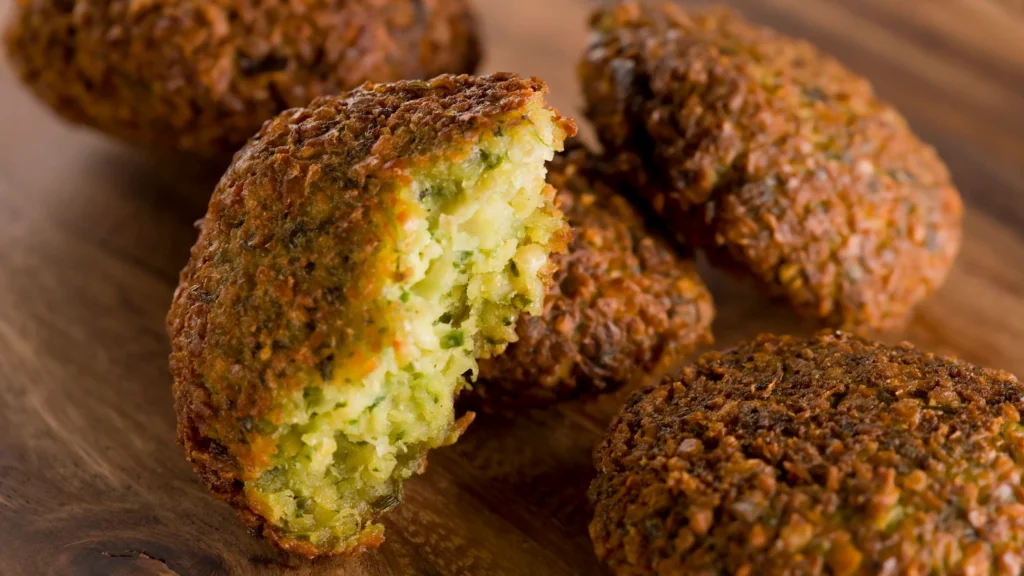
Falafel is a beloved dish in Middle Eastern cuisine, and while its exact origins are debated, it’s widely popular in Israel and often considered a national dish there.
History and Background
- Falafel’s origins are a subject of debate. Some believe it originated in Egypt, where it was made from fava beans, while others argue it has older or varied origins in the Levant.
- The dish spread throughout the Middle East and was adapted in various ways, with chickpeas becoming the primary ingredient in many regions.
- In Israel, falafel has become a staple food, often served in a pita with tahini, salad, and pickles. It’s enjoyed by people of all backgrounds and plays a significant role in Israeli street food culture.
Ingredients for Falafel
- 1 cup dried chickpeas (avoid using canned chickpeas for traditional falafel)
- 1 small onion, roughly chopped
- 2-3 garlic cloves, minced
- 3 tablespoons fresh parsley, finely chopped
- 3 tablespoons fresh cilantro, finely chopped (optional)
- 1 teaspoon ground cumin
- 1 teaspoon ground coriander
- 1/4 teaspoon chili powder (adjust to taste)
- 1 teaspoon baking powder
- 4-6 tablespoons flour or as needed
- Salt to taste
- Oil for frying (traditionally, sesame oil or another vegetable oil)
Israeli Cuisine Recipes for Falafel
Preparing Chickpeas
Soak the dried chickpeas in cold water for at least 12-24 hours. They will double in size as they soak. After soaking, rinse them thoroughly.
Making the Falafel Mixture
In a food processor, combine the soaked chickpeas, chopped onion, minced garlic, parsley, cilantro (if using), cumin, coriander, chili powder, and salt. Process until the mixture is fine and grainy, but not too smooth.
Transfer the mixture to a bowl and add the baking powder and flour. Start with 4 tablespoons of flour and add more if needed. The mixture should hold together when you form it into balls.
Shaping and Resting
- With your hands or using a falafel scoop, shape the mixture into small balls or patties. If the mixture doesn’t hold well, you may need to return it to the food processor or add a bit more flour.
- Let the falafel balls/patties rest for about 15 minutes.
Frying Falafel
- Heat the oil in a deep frying pan over medium heat. The oil should be hot but not smoking. You can test the temperature by dropping a small piece of the mixture into the oil; if it sizzles immediately, it’s ready.
- Fry the falafel balls/patties in batches to avoid overcrowding the pan. Fry until they’re golden brown on all sides.
- Remove the falafel from the oil using a slotted spoon and place them on paper towels to drain any excess oil.
Serving Falafel
Serve hot inside pita bread with toppings such as tahini sauce, diced tomatoes, cucumbers, onions, lettuce, and pickles. Falafel can also be served on its own with a side of tahini for dipping.
Falafel has transcended its regional origins to become a global vegetarian favorite, cherished for its crispy exterior, flavorful interior, and compatibility with various accompaniments. Whether enjoyed in Israel or elsewhere, it’s a taste of Middle Eastern culinary tradition.
Israeli Food – Hummus
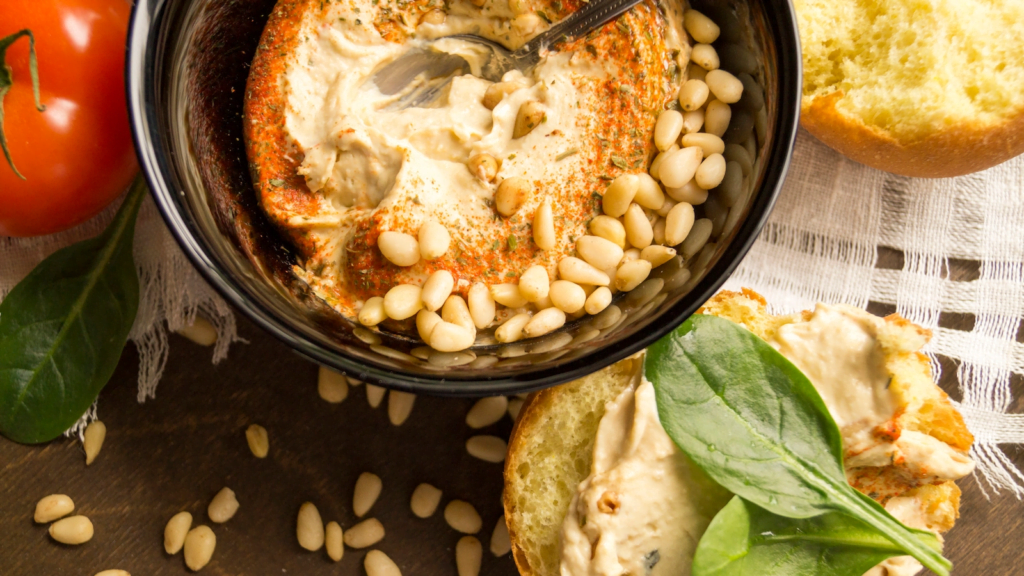
Hummus is a creamy, savory spread made primarily from chickpeas and tahini. It’s a staple in Middle Eastern cuisine and has become increasingly popular worldwide.
History and Background
- The word “hummus” means “chickpea” in Arabic.
- While the exact origins of hummus are not definitively known, the basic ingredients have been consumed in the Middle East for thousands of years.
- Different regions have their variations and ways of serving it, but its core ingredients remain largely consistent.
- In Israel, hummus has a deep cultural and culinary significance. It’s not only a dish but also a tradition, with family recipes passed down through generations. Israelis consume it in vast quantities, and “hummusiyas” (hummus eateries) can be found throughout the country.
Israeli Cuisine – Ingredients for Hummus
- 1 cup dried chickpeas (or you can use canned chickpeas for a quicker version)
- 1/4 cup fresh lemon juice (about 1 large lemon)
- 1/4 cup tahini (sesame paste)
- 2-3 garlic cloves, minced
- 2-3 tablespoons extra virgin olive oil, plus more for serving
- 1/2 to 1 teaspoon ground cumin
- Salt to taste
- 2 to 3 tablespoons water or reserved chickpea cooking water
- Paprika or sumac and chopped fresh parsley, for garnish (optional)
Israeli Cuisine Recipes for Hummus
Preparing the Chickpeas (if using dried chickpeas)
- Soak the chickpeas in water overnight with 1 teaspoon of baking soda.
- Drain and rinse the chickpeas, then place them in a pot with fresh water.
- Bring to a boil, then reduce to a simmer, cooking until the chickpeas are very tender, about 1-2 hours. Skim off any foam or skins that float to the surface.
- Reserve some of the cooking water, then drain the chickpeas.
Making the Hummus
- In a food processor or high-powered blender, combine the tahini and lemon juice and process for about 1 minute. This helps whip and cream the tahini.
- Add additional ingredients: olive oil, minced garlic, ground cumin, and a 1/2 teaspoon of salt to the whipped tahini and lemon juice mixture. Process for 30 seconds, scrape the sides and bottom of the bowl then process another 30 seconds.
- Add half of the chickpeas to the food processor and process for 1 minute. Scrape sides and bottom of the bowl, add remaining chickpeas and process for 1-2 minutes or until thick and quite smooth.
- If the consistency is too thick or still has tiny bits of chickpea, with the food processor turned on, slowly add 2 to 3 tablespoons of water or the reserved chickpea cooking water until the consistency is smooth and creamy.
Serving
- Transfer the hummus to a bowl, then drizzle with olive oil and sprinkle with paprika or sumac and chopped parsley, if desired.
- It’s traditionally served with pita bread, but it’s also great with vegetable sticks or as a spread in sandwiches.
Hummus is more than just a dip; it’s a versatile dish that can be incorporated into a variety of meals or eaten on its own. Its rich history and adaptability have made it a beloved staple in many parts of the world, especially in Israeli cuisine.
Israeli Food – Shakshuka
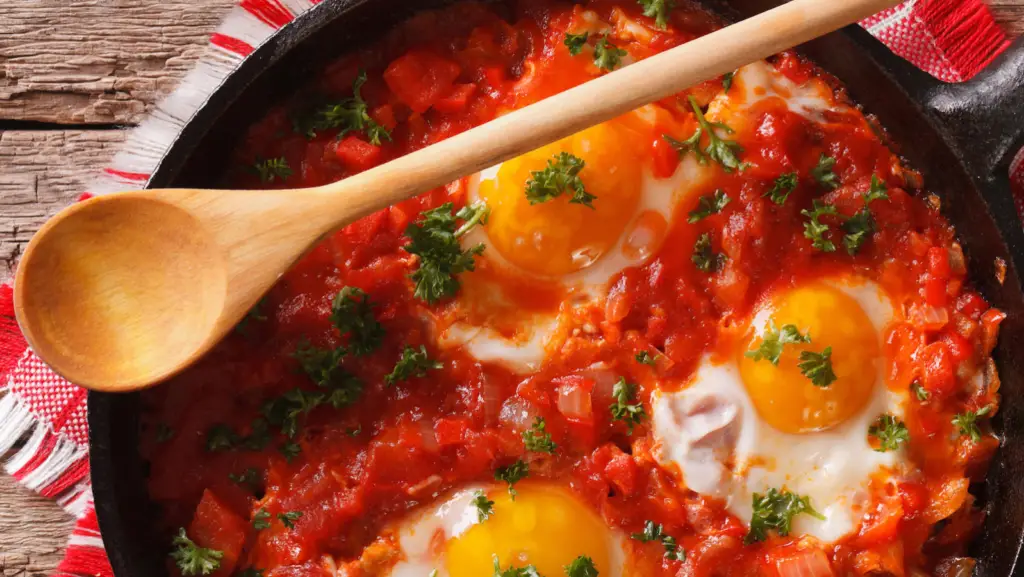
Shakshuka is a flavorful and popular dish often associated with Israeli cuisine, though its origins trace back to various parts of North Africa.
History and Background
- Shakshuka, which translates to “mixture” or “shaken” in some Arabic dialects, is believed to have originated in North Africa, particularly Tunisia.
- Jewish immigrants from North Africa brought the dish to Israel, where it was enthusiastically adopted and adapted.
- In Israel, shakshuka has become a staple, often enjoyed for breakfast but suitable for any meal of the day.
- While the traditional version features poached eggs in a spicy tomato and pepper sauce, there are many variations incorporating different ingredients, such as feta cheese, spinach, or even eggplant.
Ingredients for Shakshuka
- 1 large onion, finely chopped
- 1 red bell pepper, chopped
- 3-4 garlic cloves, minced
- 4 cups ripe tomatoes, chopped (or one 28-ounce can of whole tomatoes, crushed)
- 2 tablespoons tomato paste
- 1 teaspoon ground cumin
- 1 teaspoon paprika (sweet or smoked, based on preference)
- 1/4 teaspoon cayenne pepper (adjust to taste)
- 1 teaspoon ground black pepper
- 1 teaspoon sugar (optional, to taste)
- Salt, to taste
- 5-6 large eggs
- 1 small bunch of fresh cilantro, chopped
- 1 small bunch of fresh parsley, chopped
- 2 tablespoons olive oil or vegetable oil
Israeli Cuisine Recipes for Shakshuka
Preparing the Base
In a deep skillet or frying pan, heat the oil over medium heat. Add the chopped onion and red bell pepper. Sauté until the onion becomes translucent and the pepper softens.
Add the minced garlic and sauté for another 1-2 minutes, ensuring the garlic doesn’t burn.
Building the Sauce
Add the chopped tomatoes and tomato paste to the skillet. Stir well, breaking down the tomatoes (if using whole) with a spoon or spatula.
Add the cumin, paprika, cayenne pepper, black pepper, salt, and sugar (if using). Stir well and allow the mixture to simmer for 10-15 minutes until the sauce thickens.
Adding the Eggs
Using a spoon, create small wells in the sauce and carefully break an egg into each well. It’s essential to keep the yolks intact.
Cover the skillet with a lid and let it simmer for about 5-7 minutes, or until the egg whites are set but the yolks remain runny. For firmer yolks, you can cook for an additional 2-3 minutes.
Final Touches and Serving
- Sprinkle the chopped cilantro and parsley over the top.
- Serve the shakshuka directly from the skillet. It pairs perfectly with crusty bread or pita to scoop up the sauce and the soft yolks.
Shakshuka is a dish that’s rich in flavor and history. Its combination of simple ingredients results in a hearty and comforting meal, and it’s a beautiful representation of the melding of cultures in Israeli cuisine.
Israeli Food – Sabich
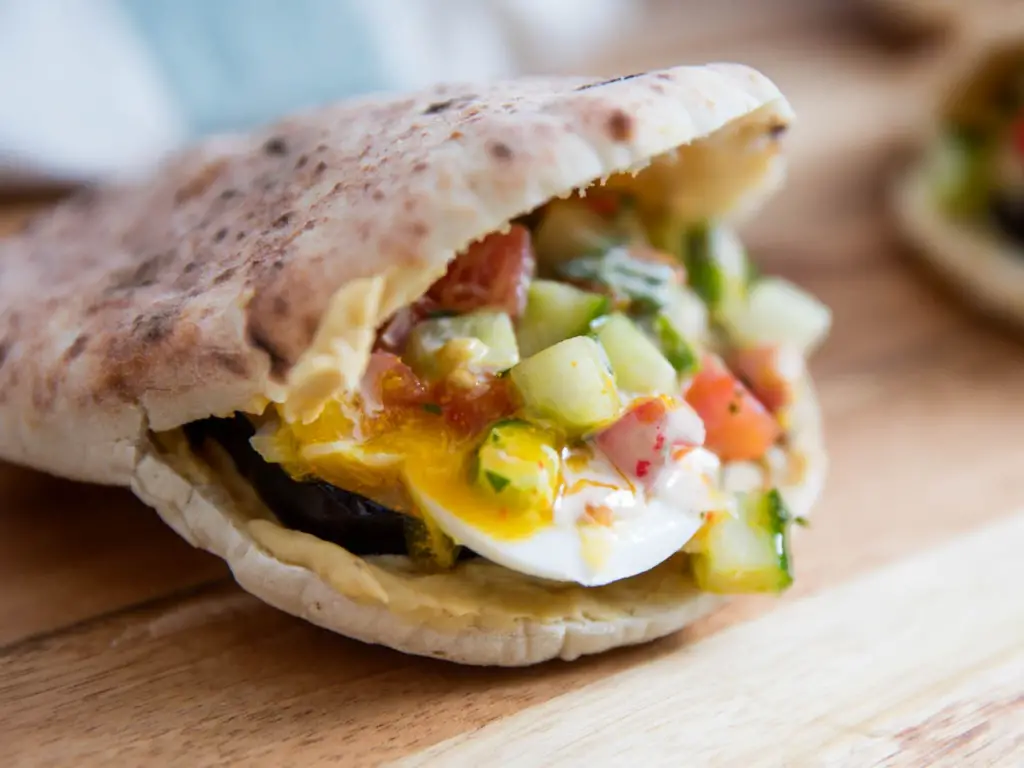
Sabich is a flavorful Israeli sandwich with origins linked to the Jewish community from Iraq.
History and Background
- Sabich is believed to have its roots among Iraqi Jews, who traditionally ate a cold meal of cooked vegetables and eggs on the Sabbath morning. This meal was composed of ingredients prepared a day earlier, as no cooking is allowed on the Sabbath.
- Jewish immigrants from Iraq brought this tradition to Israel in the 1940s and 1950s. The ingredients were later stuffed into a pita, leading to the creation of the Sabich sandwich.
- It has since become a popular street food in Israel, joining the ranks of falafel and shawarma as a beloved quick eat.
Ingredients for Sabich
For the Sandwich
- Pita bread
- Fried eggplant slices
- Hard-boiled eggs, sliced or halved
- Israeli salad (diced tomatoes, cucumbers, onions, and parsley, seasoned with lemon juice, olive oil, and salt)
- Tahini sauce (tahini paste, lemon juice, water, and salt mixed to a drizzling consistency)
- Optional: Amba (a tangy mango pickle condiment)
- Optional: Hummus
- Optional: Pickles
For the Fried Eggplant
- 1 large eggplant, sliced into 1/2-inch rounds
- Salt, for drawing out moisture from eggplant
- Vegetable oil, for frying
Israeli Cuisine Recipes for Sabich
Preparing the Eggplant
- Lay the eggplant slices on a tray and sprinkle both sides with salt. Allow them to sit for about 30 minutes to draw out the moisture. This step helps reduce the bitterness and makes the eggplant less oily when fried.
- Rinse the eggplant slices to remove the excess salt and pat them dry with paper towels.
- Heat vegetable oil in a frying pan over medium heat. Once hot, add the eggplant slices in batches, frying until they’re golden brown on both sides.
- Remove the fried slices and place them on a plate lined with paper towels to drain excess oil.
Assembling the Sabic
- Slice open the pita bread to create a pocket.
- If using, spread a layer of hummus inside the pita.
- Add a layer of fried eggplant slices and a couple of slices or halves of hard-boiled egg.
- Add a generous amount of Israeli salad.
- Drizzle with tahini sauce. If you’re using Amba, add it now.
- Optionally, you can add some pickles for an extra crunch and tang.
Serving
Sabich is best served immediately once assembled. The combination of warm bread and eggplant with the cool salad and sauces creates a delightful contrast.
Like many dishes in Israeli cuisine, Sabich is a fusion of tastes and traditions from different communities, resulting in a unique and delicious sandwich that tells a story of migration and cultural melding.
Israeli Food – Kanafe
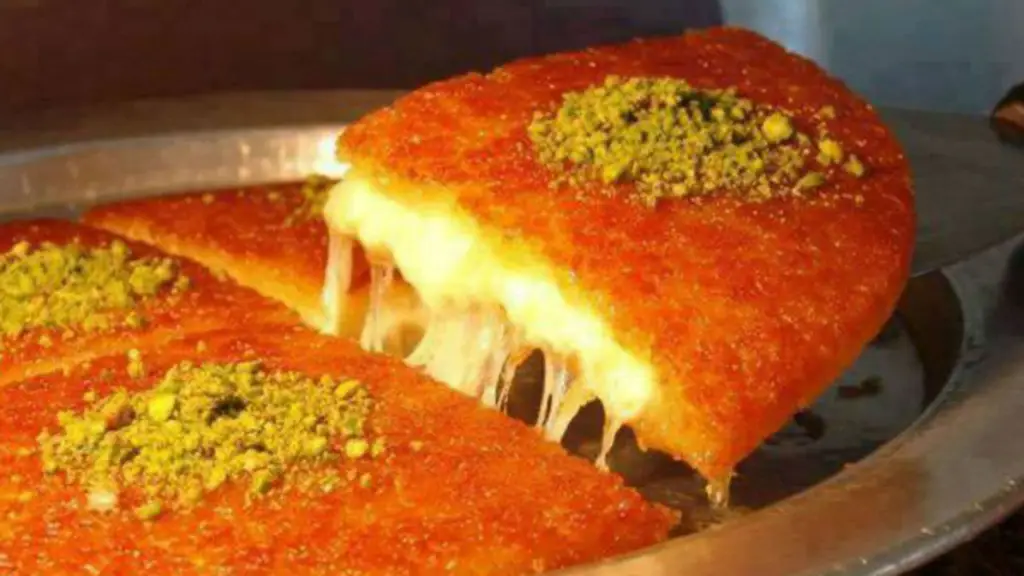
Kanafeh (also spelled as “kunafa,” “knafeh,” “konafah,” etc.) is a dessert that has its roots in the Arab world and is enjoyed throughout the Middle East, including in Israel. While not originating in Israel, the dessert has been embraced and adapted by the diverse communities in the country.
History and Background
- Kanafeh is believed to have originated in the Palestinian city of Nablus, though variations of it can be found throughout the Middle East.
- The dessert consists of thin noodle-like pastry (or alternatively semolina dough) soaked in sweet, sugar-based syrup and layered with cheese, or in some variations, thick cream.
- In Israel, kanafeh is particularly popular among the Arab communities and can be found in Arab bakeries throughout the country. The city of Jaffa (Yafo) is particularly known for its kanafeh.
- The dish symbolizes celebrations and festive occasions in many cultures.
Ingredients for Kanafeh
Kanafeh
- 1 package (500g) of kadaif noodles (found in Middle Eastern stores)
- 2 cups of unsalted cheese (mozzarella, ricotta, or a mix, but traditionally a soft white brined cheese like Nabulsi is used)
- 1 cup of melted unsalted butter or ghee
Syrup
- 1 cup sugar
- 1/2 cup water
- 1 teaspoon lemon juice
- 1 teaspoon rose water or orange blossom water (optional)
Garnish
- Ground pistachios
- Ground cinnamon (optional)
- Rose petals (optional)
Israeli Cuisine Recipes for Kanafeh
Preparing the Syrup
- In a saucepan, combine sugar, water, and lemon juice.
- Bring the mixture to a boil, then reduce the heat and let it simmer until the sugar is dissolved and the syrup thickens (about 10 minutes).
- Remove from heat and stir in the rose water or orange blossom water, if using. Set aside to cool.
Preparing the Kanafeh Base
- Pull apart and untangle the kadaif noodles. Cut them into shorter lengths for easier handling.
- In a large mixing bowl, combine the noodles with melted butter or ghee, ensuring the noodles are well-coated.
- In a round baking tray, spread half of the buttered noodles, pressing them firmly into the base.
- Spread the cheese evenly over the noodle layer.
- Cover the cheese with the remaining noodles, pressing gently.
Baking
- Preheat your oven to 350°F (175°C).
- Bake the kanafeh for about 30-40 minutes or until the top turns a golden brown.
- Once out of the oven, while still hot, pour the cooled syrup over the kanafeh, allowing it to soak in.
Serving
- Garnish with ground pistachios and, if desired, a sprinkle of ground cinnamon or rose petals.
- Kanafeh is best served warm, allowing the contrast of the crispy top, soft cheese, and sweet syrup to be most pronounced.
Kanafeh is a rich and indulgent dessert, and its history, spanning multiple cultures and regions, speaks to its beloved nature and ability to bring people together over a shared love of sweet treats.
Israeli Food – Halva

Halva, also known as “halvah” or “helva,” is a dense, sweet confection that’s popular across the Middle East, the Balkans, Central Asia, and the Mediterranean region. In Israel, it holds a special place in the culinary landscape.
History and Background
- The term “halva” is derived from the Arabic word “ḥulw,” meaning sweet.
- The origins of halva are ancient, with different versions emerging in various cultures. It’s been suggested that an early form of halva was made in Persia from dates and milk.
- In Israel, sesame halva (made from tahini) is especially popular and has been embraced by the diverse communities in the country. The city of Jerusalem, in particular, is known for its high-quality halva.
- Halva can be found in myriad flavors and varieties in Israeli markets, often with additions like chocolate, pistachios, coffee, and more.
Israeli Cuisine Recipes – Ingredients for Sesame Halva
- 1 cup tahini (sesame paste)
- 1 cup sugar
- 1/2 cup water
- 1 teaspoon vanilla extract (optional)
- Optional additions: nuts (like pistachios or almonds), cocoa powder, chocolate chips, dried fruit, etc.
Israeli Cuisine Recipes for Sesame Halva
Preparing the Sugar Syrup
- In a saucepan, combine the sugar and water. Heat over medium-high heat without stirring until the sugar has dissolved and the mixture reaches a temperature of about 260°F (127°C) or the “hard ball” stage. If you don’t have a candy thermometer, drop a bit of syrup into cold water. It should form a hard but pliable ball.
- Remove the saucepan from the heat.
Making the Halva
- In a separate bowl, stir the tahini and vanilla extract until well combined.
- Gradually pour the hot sugar syrup into the tahini, stirring constantly. The mixture will thicken rapidly.
- If you’re using any additions like nuts, cocoa powder, or dried fruit, fold them in now.
- Transfer the mixture to a greased mold or a dish lined with parchment paper. You can use a loaf pan, a square dish, or any shape you prefer.
- Press down firmly to ensure the mixture is compacted and even.
Setting and Serving
- Allow the halva to cool to room temperature, then place it in the refrigerator for several hours or overnight to set completely.
- Once set, remove the halva from the mold, slice, and serve.
Halva, with its rich history and presence in many cultures, embodies the melting pot of traditions in Israeli cuisine. Its delightful sweetness and versatility make it a favorite among many, enjoyed both as a treat and as a symbol of celebration.
Conclusion
Thank you for joining me on this culinary journey through the vibrant and flavorful world of Israeli cuisine. We’ve explored the rich culinary traditions, unique spices, and unforgettable flavors that make Israeli Cuisine Recipes truly special. From traditional dishes to modern innovations, Israeli cuisine offers a delightful fusion of cultures and flavors that are sure to impress.
Whether you’re craving a comforting bowl of hummus or want to experiment with fusion flavors, Israeli Cuisine Recipes are a great addition to any kitchen. With the diverse origins and ingredients used in Israeli cooking, you can enjoy a taste of the Mediterranean in every dish.
So don’t be afraid to get creative and try your hand at some Israeli Cuisine Recipes. With the essential spices and ingredients we’ve covered, you can elevate your dishes with the authentic flavors of Israel. I hope this article has inspired you to explore Israeli cuisine and create unforgettable meals that will transport you to the colorful streets of this beautiful country.
FAQ’s
What is Israeli cuisine (Israeli cuisine recipes)?
Israeli cuisine is a delightful fusion of Middle Eastern and Mediterranean flavors, with influences from various culinary traditions. It is known for its bold and vibrant flavors, fresh ingredients, and diverse dishes.
What are the characteristics of Israeli Cuisine Recipes?
Israeli cuisine recipes are a diverse blend of Middle Eastern and Mediterranean flavors. They often feature ingredients like tahini, chickpeas, and fresh herbs. From the popular hummus and falafel to shakshuka and sabich, there are plenty of delicious Israeli dishes to explore with these authentic recipes.
What are some traditional Israeli Cuisine Recipes?
Some traditional Israeli dishes include falafel, hummus, shakshuka, sabich, and Israeli salad. These dishes showcase the rich cultural heritage and flavors of Israeli cuisine.
Are Israeli Cuisine Recipes difficult to recreate at home?
Israeli Cuisine Recipes can be easily recreated at home with a little effort and the right ingredients. Many traditional Israeli dishes are simple and rely on fresh ingredients and basic cooking techniques.
What are some essential Israeli Cuisine Recipes?
Some essential Israeli spices include za’atar, sumac, turmeric, and cumin. These spices add depth and complexity to Israeli dishes and contribute to the unique flavors of the cuisine.
Can I incorporate Israeli flavors into my own cooking?
Absolutely! You can incorporate Israeli flavors into your own cooking by experimenting with different spices, trying out traditional Israeli recipes, and adding a Mediterranean twist to your dishes.
Last Edited

